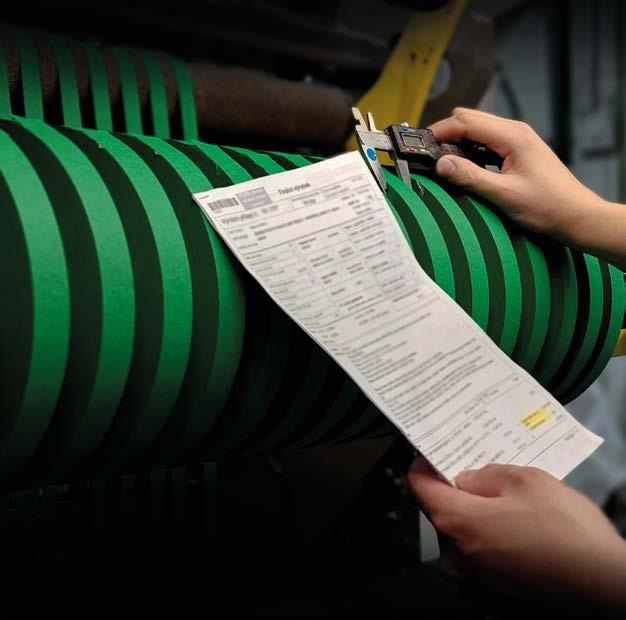

AEROSPACE EQUIPMENT more than 100 years on the market since 1919

HYDRAULIC GEAR PUMPS
HYDRAULIC GEAR MOTORS
FLOW DIVIDERS




Development, production, sales and service of hydraulic and aerospace systems and components



AEROSPACE EQUIPMENT more than 100 years on the market since 1919

HYDRAULIC GEAR PUMPS
HYDRAULIC GEAR MOTORS
FLOW DIVIDERS




Development, production, sales and service of hydraulic and aerospace systems and components

Editor-in-Chief: Pavla Podskalská
Editor: Marie Ciganeková
Graphic design: Stanislava Podaná
Production: Renáta Rudlofová, Stanislava Podaná
Cover: pixabay.com
Translation: Lenka Lebedová
Proofreading: Ivana Kadlecová, Pearl Harris
Issued by: PP Agency s.r.o. Myslíkova 25, 110 00 Praha 1, Czech Republic www.ppagency.cz, e-mail: journal@ppagency.cz
Deadline: 1 June 2023
Copyright: PP Agency s.r.o. ISSN 1211-0949
It is not allowed to reproduce any part of the contents of this book without prior consent from the Editor.

Dear Readers,
For traditional and new business partners of the Czech Republic, we are releasing the publication titled “Doing Business in the Czech Republic – The Best of Czech Industry”, the purpose of which is to draw your attention to the products and services of a small, but reliable country, for which the proverb “A trade in hand finds gold in every land“ has always been true and where people are industrious and inventive.
The Czech Republic has a stable position in the international exchange of goods and services and is an active participant thereof. This is enabled in the first place by its strongly export-oriented economy. Exports play a crucial role in the Czech economy. Exported goods and services generate a large part of the gross domestic product, with the main export sectors including the automotive industry, mechanical engineering, electronics, the chemical industry, and food production.
A typical feature of the exports of the Czech Republic is its geographical diversification: the Czech Republic searches for new market opportunities for its products and services actively, focusing not only on traditional business partners in the European Union (especially Germany, Slovakia, and Poland), but also on fledgling markets in Eastern Europe, Asia, Africa, and Latin America.
In addition, our international trade is supported by foreign investment and membership in international groupings and organisations, as well as numerous international business treaties, enabling the free movement of goods and services among EU member states and other countries worldwide.
The Bohemian Lands went through the Industrial Revolution in the 19th century. It led to the development of heavy industry, such as coal mining and metallurgy. In that era, also the development of the textile and glass industry started. After the establishment of Czechoslovakia in 1918, the industrial sector started to thrive, thanks to modernisation and the infrastructure development. An important role was assumed by the automotive industry, especially the Škoda brand. Mechanical engineering was also on
the rise. During the communist era, the whole industrial sector was nationalised in Czechoslovakia and subject to central planning. This era gave rise to large state-owned enterprises producing various articles and engaged in all sectors of the economy, ranging from heavy industry up to consumer goods.
After the collapse of communism in 1989 and the split of Czechoslovakia in 1993, the Czech industrial sector went through a period of transformation. Privatisation of state-owned enterprises started and Czechia opened up to the global market. Many enterprises underwent the process of restructuring and modernisation.
At present, the Czech industrial sector is diversified and modernised. The automotive industry is still one of the main pillars. However, an important role is also played by the manufacture of machines, electronics, the chemical industry and food production. Moreover, the Czech Republic has become an attractive location for foreign investments, due to its strategic geographic position and qualified labour force.
In the Bohemian Lands, some trades have a really long tradition, dating back to the mediaeval period and even to older times. Trades are an important part of the cultural and industrial heritage of this country.
For instance, the history of the glass industry in the Bohemian Lands dates back to the 13th century. It is connected with numerous towns and regions, such as Křivoklátsko, Jizera Mountains, Lusatian Mountains and Šumava. Bohemian glass used to be and still is world famous for its quality, variety and innovative technology. In addition, the manufacture of ceramics and porcelain in the Bohemian Lands dates back to the Middle Ages. Our porcelain and ceramic products are renowned for their delicacy, quality and handcraftsmanship.
Similarly, the skills of Bohemian blacksmiths manufacturing tools, arms, decorations, and metal structures date back to the Middle Ages. In the same period, the weaving and textile industry in our country was on the rise, too. Bohemian lace and fabrics were sought after throughout Europe and Bohemian textile products were greatly appreciated for their quality and design.
Carpentry and cabinet-making are traditional crafts in the Bohemian Lands and have a long history. Bohemian furniture is renowned for its quality, precision and handcraftsmanship. The Bohemian craft of carpentry has deep roots in the Bohemian Lands.
The Czech Republic is currently known especially for its manufacture of cars and the automotive industry, in the first place thanks to the Škoda Auto company, which is one of the biggest employers in this country. Besides Škoda Auto, there are also other high-profile global automotive manufacturers and suppliers operating in this country.
The Czech Republic has a long history in the field of mechanical engineering as well. This sector includes the manufacture of machines
and equipment for various industrial sectors, such as machine tools, robotics, and the manufacture of components. The Czech industrial sector also takes a significant part in the production of electronics and electrotechnics, including consumer electronics, electrical components and equipment for the energy sector and telecommunications. Another important sector is the chemical and pharmaceutical industry. It includes the production of chemicals, plastics, pharmaceuticals, pigments and other products.
The food industry and agriculture also have a long tradition. Czech beers, milk products, confectioneries and other food products are popular worldwide.
The geographical position of the Czech Republic in the centre of Europe predetermines its important role in transport and logistics, including rail, road and waterways’ freight transport, as well as warehousing and logistics services.
The Škoda car brand, which belongs to the Volkswagen Group, is known worldwide for its high-quality cars, reliability and innovative design. Models such as Škoda Octavia, Škoda Superb and Škoda Kodiaq have gained general popularity and have a strong position on international markets. However, this does not only apply to Škoda cars. For example, Avast is one of the leading global providers of security software and antivirus solutions. Their products such as Avast Antivirus are used by millions of people worldwide and have a good reputation for their effectivity and reliability.
ESET, another Czech provider of antivirus software, called ESET Antivirus, is known for its efficient security products and is one of the leaders in the field of cybersecurity.
Everyone knows Pilsner Urquell, one of the most popular Czech beers, which ranks among the founders of the pilsner beer style. This beer is globally popular for its typical flavour profile and history. In addition, Jawa and ČZ are historical Czech brands of motorcycles, which are still popular with lovers of motorcycles worldwide for their reliability, durability, and iconic design.
Czech people are also very proud of Baťa, the company founded by Tomáš Baťa, a Czech-born industrialist, and now operating internationally as one of the largest shoe manufacturers worldwide.
Czechia contributes to the world not only with its products, but also with its inventions and innovations. Our publication will present these to you. To name a few now, let´s mention at least the Global Navigation Satellite System (GNSS), which is known under the name Galileo and has contributed to the research of outer space. Galileo is a European satellite navigational system, providing independent navigation and location information for users worldwide. The Czech Republic has been engaged in its development and has supplied several crucial components and technologies to Galileo. Czech Industry and Environmental Protection
It is important to us to preserve a clean and harmless environment for future generations. That is the reason why Czech industry endeavours that its manufacture is environmentally-friendly and its environmental footprint is minimised. We are investing in the modernisation of our manufacturing processes and in the implementation of clean technologies to reduce emissions of contaminants in the air, waters and soil. This means, for instance, the installation of filters and purifiers, reducing emissions of dust, nitrogen oxides and other contaminants. We are focusing on the improvement of the energy efficiency of manufacturing facilities. This includes investment in advanced technologies and equipment, reducing the energy de -
mands and minimising energy losses during manufacturing processes. We are actively promoting recycling and the correct disposal of waste. Waste separation and recycling, the minimisation of waste materials in industrial processes and the utilisation of byproducts and waste as materials for further production are done as a matter of course.
We are investing in the research and development of new technologies and innovations that help to protect the environment. This includes the development of eco-friendly materials, processes and technologies, which minimise the adverse impacts on the environment.
Our wish is that you find as much useful information as possible in this publication and many new business partners in the Czech Republic.
THE EDITORIAL STAFF

ICC is – and has been throughout its long existence – a steadfast rallying point for those who believe, like our founders, that strengthening commercial ties among nations is not only good for business but good for global living standards and good for peace. ICC was founded in 1919 in Paris. Today, ICC represents 6.5 million companies and associations in more than 130 countries and transmits their interests to high official representatives including the UN, EU, W TO, OECD and G20, where ICC has been granted the highest level of consultative status.
The main aim of ICC Czech Republic is to assist Czech companies and other businesses to integrate into world events through this prestigious global organisation. Within the framework of its activities, ICC Czech Republic creates opinions and statements on issues sent by ICC Headquarters for examination. At the same time, this agenda is influenced, so as to be in compliance with the interests of ICC Czech Republic members The National Committee of ICC in the Czech Republic serves the role of coordinator of the business community activities in the Czech Republic and represents its interests in dealing with both national and international organisations and governments.
Being an ICC member is a question of prestige.
ICC creates rules and principles that are fully respected and used in everyday business and has become one of the most important pillars of international trade.
ICC provides a large portfolio of services fundamental to foreign trade, such as educational and advisory services, as well as creating opportunities for establishing partnership with foreign business partners. ICC Czech Republic was founded in 1999. The main aim of ICC Czech Republic is to assist Czech companies and other businesses to integrate into world events through this prestigious global organisation.
The main aim of these workshops is to support the efficiency of Czech economic diplomacy in the presence of Czech ambassadors, to introduce trade and investment opportunities to Czech exporters, to help diversify Czech export to perspective markets and to help establish useful business contacts.
Our extensive range of educational programmes is targeted at specific topics associated with conducting international trade. Lecturers include experts and professionals with longtime experience or managers working in the given field – Incoterms 2020, Bank guarantees and experience with URDG 758 and ISDGP, Documentary Credits and Standbys – International Standard Banking Practice and Practices, Terms of International Sales Contracts in Foreign Trade. In addition to seminars on banking technology and practice, we also organise workshops focusing on transport and logistics, and arbitration, law, mediation and negotiation. We try to supplement traditional topics with current topics that are related to foreign trade.
ICC Rules and Guidelines are used worldwide, simplifying transactions and promoting good business practices. We have prepared and offer for sale professional publications in Czech.

STATE SYMBOLS OF THE CZECH REPUBLIC
The Czech Republic is a landlocked country situated in Central Europe and bordering on Germany, Austria, Slovakia, and Poland.
Population 10 873 553
Area 78 864 sq.km
Capital city Prague Parliamentary system Parliamentary democracy
Language Czech
Highest peak Sněžka (1603 m.a.s.l.)
Time zone
Central European time GMT + 1, summer time GMT + 2
Currency Czech crown (Kč/CZK) = 100 hellers
For the most recent exchange rates, please see https://www.xe.com/ currencyconverter
Internet domain: .cz
The President of the Czech Republic: Petr Pavel
The Czech Republic is a member of the European Union, the United Nations, NATO, WTO, the International Monetary Fund, the International Bank for Reconstruction and Development, the European Bank for Reconstruction and Development, OECD, and many other organisations.
The UNESCO World Cultural Heritage List comprises the following cities and sites: Prague, Český Krumlov, Kutná Hora, Litomyšl Chateau, Telč, Lednice-Valtice area, Zelená Hora (Green Mountain – St. Jan of Nepomuk Church, Holašovice, Kroměříž (castle and gardens), Holy Trinity Column in Olomouc, Tugendhat Villa in Brno (architect Ludwig Mies van der Rohe), St. Procopius Basilica and the Jewish Quarter in Třebíč. In 2005, the Moravian-Slovakian Verbuňk recruitment dance was inscribed on the UNESCO Intangible Cultural Heritage List. In 2010, another entry on the List was the Shrovetide Carnival and Falconry and, in 2011, the Moravian-Slovakian Ride of the Kings. Czech puppetry was listed in 2016 and in November 2018, the textile printing technique called blueprint was included. Also the spa triangle – Karlovy Vary, Mariánské Lázně, and Františkovy Lázně – was, together with other eight famous European spas, added to the UNESCO World Heritage List in 2021, upon the international series nomination of “Great Spas of Europe”. The decision to do so was adopted by the intergovernmental World Heritage Committee on 24 July 2021. In 2021, the traditional Czech blown-glass and beaded Christmas decorations were also added to UNESCO’s celebrated list of Intangible Cultural Heritage.
For additional practical information on the conditions of transport to the Czech Republic and stay in the CR, see ww w.czech.cz
Czechs are considered a very cultured nation, which has given the world a number of significant persons. The most important rulers and heads of state are Emperor Charles IV and the Presidents T.G. Masaryk and Václav Havel. World renowned personalities include the scientists Jaroslav Heyrovský (holder of the Nobel Prize for Chemistry), Otto Wichterle, Czech chemist who invented contact lenses,

and Antonín Holý, who helped to create a drug used in the treatment of AIDS. Other world renowned persons are Tomáš Baťa, creator of the shoe empire between the two World Wars, and Madeleine Albright, former US Secretary of State. In the field of culture, great names are those of the composers Bedřich Smetana, Leoš Janáček, Antonín Dvořák, and Bohuslav Martinů, the writers Franz Kafka, Karel Čapek, Jaroslav Seifert (holder of the Nobel Prize), Jaroslav Hašek, Bohumil Hrabal, and Milan Kundera. Oscars have been awarded to film directors Miloš Forman (born in the Czech Republic), Jiří Menzel, and Jan Svěrák. Other famous people of culture are the painters František Kupka and Alfons Mucha, and the photographer Jan Saudek. Sportsmen who have gained international fame are, for example, Emil Zátopek – long-distance runner – best known for winning three gold medals at the 1952 Summer Olympics in Helsinki. He won gold in the 5 000- metre and 10 000-metre races, but his final medal came when he decided at the last minute to compete in the first marathon of his life. He was nicknamed the “Czech Locomotive”.
Gymnast Věra Čáslavská won a total of 22 international titles between 1959 and 1968, including seven Olympic gold medals, four World titles, and eleven European championships.
Martina Navrátilová is a former Czechoslovak and later American professional tennis player and coach. In 2005, Tennis magazine selected her as the greatest female tennis player for the years 1965 through 2005. She is considered one of the best, if not the best, female tennis players of all time.
Jaromír Jágr is the most successful European hockey player who has ever played in the NHL and is considered one of the greatest professional hockey players of all time.
Petr Čech is considered one of the greatest and most respected football goalkeepers of his generation.
Barbora Špotáková is a track and field athlete who competes in the javelin throw. She is a two-time Olympic and World Champion.
Petra Kvitová is a professional tennis player. She turned professional in 2006 and has won 23 career single titles, which includes two Grand Slam titles at the Wimbledon Championships in 2011 and 2014.
Martina Sáblíková is a speed skater, specialising in long-distance races. She is an Olympic gold medal winner and a multiple European and World all-round champion. She became the first Czech to win two Olympic gold medals at one Winter Games in the 2010 Olympiad.
Ester Ledecká is a snowboarder and Alpine skier. At the 2018 Winter Olympic Games in Pyeongchang, Ledecká won gold medals in the super-G in Alpine skiing and in the parallel giant slalom in snowboarding. She is the first person to win two gold medals at the same Winter Olympics, using two different types of equipment (skis and snowboard) and the first woman to do so in a single Winter Olympics.
* For more information about some exceptional Czech persons, see the following sections of the publication
Country dialling code: +(420).
Licences for Mobile telephone network covering the territory of the Czech Republic have been granted to a couple of companies: for example O2 Czech Republic, a.s., T-Mobile Czech Republic a.s., Vodafone Czech Republic a.s. The most widely used credit cards in the Czech Republic are: Eurocard/Mastercard and Visa
In 2023, the Czech economy as a whole struggled with attenuation of its performance. The Czech Republic was the only country in Europe which did not get back to the pre-COVID growth of its economy. The inflation rate was high, the real wages’ decline continued, expensive energies were not handled, and the investment rate was low. Worse economic outcomes in numerous productive and non-productive sectors and especially the persisting low household consumption, decreasing for quarters, contributed to the performance slump.
According to a preliminary estimate, the gross domestic product in 2023 will show a decrease. In all quarters, the growth was adversely affected, especially by a decrease in household final consumption and depletion of inventories. A positive contribution was influenced by the expenditure on the final consumption of governmental institutions, the gross fixed capital formation and the foreign demand, especially in the first half of the past year. In the formation of the gross valued
added, the decrease was influenced by worse economic outcomes, especially in the manufacturing industry, and also in numerous sectors of trade, transport, hospitality industry, health care, social care, and the education sectors.
In 2023, the total industrial production was lower than a year before, especially due to a decrease in the production in the sectors of mining and excavation and in a prevailing number of other sectors. The slight growth in the production of motor vehicles was not able to make up for this slump, especially with lower economic outcomes of the production of machines, the production of building materials and glass. In addition, the lower value of new contracts, especially in metallurgy, metal casting and the chemical industry, can partly
Source: Czech Statistical Office, Czech National Bank (ČNB); General note: y/y shows year-on-year change in the indicator; 1) D ata after revision using the ESA 10 systém (European Systém of Accounts), year 2022 preliminary data, 2023 estimate; 2) Average share of unemployed pers ons = the number of available job applicants aged 15-64 years in relation to inhabitants of the same age (MPSV= Ministry of Labour and Social Af fairs); 3) VŠPS = Labour Force Sample Survey; 4) HICP (Harmonised Index of Consumer Prices), inflation rate in the methodology of the EU; 5) Foreign tra de data expressed in EUR are the sum of particular monthly figures in CZK, converted with the average monthly rate of exchange announced by the CNB; 6) Czech National Bank (CNB)


We have been number one in the manufacture of original clothing in the CR and EU since 1931. We export fashion to Switzerland, England, Scotland, Austria and Germany.
With pride and patriotism, we dress mainly Czech men!
men´s ready-to-wear clothing, women´s ready-to-wear clothing
workwear with GORE-TEX and NOMEX technology (such as protective clothing for firefighters and for the Army of the Czech Republic).
men´s jackets and suits are custom tailored – made directly for the specific end customer.
We place an emphasis on extending the individual selection to meet current requirements and customer needs – they require originality of their outfit, and that clothing should be an expression of their focus and personality. The most demanding customers are cared for in a new salon in Prague. This salon is very successful, so we are planning to open others in Slovakia and Austria as well.
We are gradually extending the network of our own salesrooms in the Czech Republic and, at the same time, enlarging our production capacities for products made of Gore-Tex, such as protective clothing for firefighters, outdoor clothing and workwear. www.vyvoj.cz
VÝVOJ, oděvní družstvo v Třešti Franze Kafky 341/13 | 589 01 Třešť | CR | +420 567 224 598 vyvoj@vyvoj.cz
be blamed for the deterioration of total economic outcomes. Besides the influence of the high energy demands on the manufacturing process, adverse factors included an enormous increase in prices and problems in customer-supplier relationships.
Foreign trade (cross-border movement of goods) for January – November 2023 ended up with a surplus amounting to CZK 120.8 bn.

(In the same period of 2022, there was a deficit amounting to CZK 202.4 bn.). Contrary to the same period of 2022, exports were 1.2 % higher, imports dropped by 6.4 %. The reasons for the positive balance mainly included lower imports of crude oil, natural gas, and also a decrease in the prices of these commodities.
The average annual inflation rate, expressed with the increment of consumer prices in 2023, was 1O.7 %, which is 4.4 percentage points less than in 2022. Prices for foods and non-alcoholic beverages increased, in the year-on-year comparison, by 44.3 % for alcoholic beverages. The increase was 47.5 %, for clothing and 50.4 % for shoes, 63.4 % for the group of housing, water and energies, for health care 43.1 %, for transport 32.1 %, and for services of the hospitality industry, 80.3 %. A price decrease, in the year-on-year comparison, occurred only in postal and telecommunication services.
For the last 100 years, Czech Science has given the world an enormous amount of knowledge. Thanks to our scientists, there are contact lenses and artificial blood vessels, and mankind has managed to eradicate the Variola virus and to look into the core of the smallest living organisms. The Czech contribution to inventions and discoveries can not be easily described. Bohemian, Moravian, and Silesian scientists have participated in countless studies and projects throughout the world. There are hundreds and maybe thousands of these, so let´s merely concentrate below on the few very remarkable ones.
GENETICS
The discovery of Genetics did not take place in the 20th century, but it should definitely be included in this list. This is because, in the second half of the 20th century, the discoveries that followed up on Genetics became the basis for transformation in our world. In any case, credit for the discovery of Genetics is owed mainly to one person, the solitary research of Johann Gregor Mendel – a native of Brno – whose work earned him the title of “Father of Genetics”. Mendel was the founder of Genetics and discoverer of the fundamental Laws of Inheritance. He was a monk and later Abbot of the Augustinian monastery in Staré Brno. There are no better recognised names in contemporary Genetics than Watson, Crick, and Mendel. The latter was ahead of his time and, in 1866, submitted his world-famous research paper, titled “Experiments on Plant Hybridisation”, on the principles of cross-breeding, which ultimately laid the foundation for modern Genetics.
BLOOD
Jan Janský, Professor at Charles University in Prague, was a significant Czech neurologist and psychiatrist. He became world-famous due to his classification of the four blood groups. In 1900, Karl Landsteiner was the first to discover the existence of blood groups, but he described only three groups. In 1907, Janský described all four blood groups, independently of Landsteiner, within an unclearly targeted research study on the relationship of blood and mental diseases. In 1921, the primacy of Janský was recognised in the USA and Janský´s classification is always quoted in American literature. How -
ever, the credit in general, as recognised in 1930 by the Nobel Prize, was given to Landsteiner. Janský was also engaged in research studies in the field of neuropathology, and was one of the pioneers of liquorology on a global scale.
Karel Raška, founder of the modern Czechoslovak epidemiological school, gained renown as co-contributor to the global eradication of Variola. In 1963, he became Director of the Infectious Diseases Department of the World Health Organisation (WHO) in Geneva. Four years later, the battle to eradicate Variola started under his leadership. And in just two years, 20 of the most affected African countries had eliminated the disease.
Otto Wichterle was a world-famous Czech scientist and inventor, working especially in the field of macromolecular organic chemistry as one of its founders. He is especially renowned for his discoveries and inventions leading to the essential improvement and global spread of soft contact lenses. These results were based on his original scientific work in the field of hydrogels. Contact lenses did exist in his time, but those were made of glass and other uncomfortable plastic materials, which were very impractical and unpopular. When Professor Wichterle came up with his soft gel contact lenses, he literally caused a revolution in ophthalmology. This was an absolutely brilliant invention. An irony of that time was that the lenses were manufactured worldwide, except in our country. In every democratic state throughout the world, a personality such as that of Professor Otto Wichterle would have been duly recognised. But not in the socialist Czechoslovakia of that era!
Thin, flexible tubes or artificial blood vessels impregnated with collagen, which are commonplace in medicine nowadays, rewrote the textbooks of vascular surgery of that time. They were invented by a team of scientists and doctors, led by one surgeon – Milan Krajíček (1933–2016). He dedicated himself to the research and development of venous prostheses, and obtained numerous primacies and patents in that field. Currently, the development of artificial blood vessels is being undertaken by the Technical University in Liberec. In 2016, the scientific team of Professor David Lukáš presented venous prostheses made of nanomaterial, which are going to be an invaluable aid in heart attack treatment, for example, because they prevent the formation of fatal blood clots. Scientists believe that nanomaterial is the optimal base for the cre -

ation of artificial blood vessels, as it meets multiple preconditions. It has good mechanical properties, prevents the formation of blood clots, is non-toxic, and can be sterilised. Nanomaterial even enables vessels with a small diameter of less than 6 millimetres to be manufactured. Artificial “nano-vessels” work as a kind of scaffolding, which will subsequently disintegrate when cells have grown through it and a vessel of its own arises.
Professor Antonín Holý was one of the most important Czech scientists of recent decades. A chemist of global renown, who followed the results of basic research through to the practical implementation and was behind the discovery of numerous antiviral drugs to treat millions of people throughout the world. He was involved in the creation of one of the most effective drugs in the treatment of the AIDS epidemic. The antiviral drug called Viread is manufactured on the basis of a licence to use his original discoveries, as are other effective medications to combat the herpes zoster virus, Variola, and viral conjunctivitis of the eye. In addition, another drug is used in the successful treatment of the hepatitis B virus.
The Czech Republic is a global leader in nanofibers. “Imagine if someone came up with iron in the Stone Age. In our era, nanofibers are a parallel to iron. They will penetrate every type of human activity,” says Professor Oldřich Jirsák from the Technical University of Liberec. It was precisely Professor Jirsák who invented the
nano-spider, a device which manufactures nanofibers on a large-scale basis for industrial use. Nanofibers assist in medicine, for example, as new blood vessels, as well as in water treatment, in the manufacture of special waterproof clothing and also permeable jackets and trousers. In the home, to eliminate a lot of cleaning, nanomaterials are able to repel dust and other contaminants. Professor Jirsák and his team discovered a method of manufacturing all these on a large-scale basis. This was indeed a revolutionary idea.
Bedřich Hrozný was a Czech orientalist and linguist. He contributed to the deciphering of the ancient Hittite language, identified it as an Indo-European language, and laid the groundwork for the development of Hittitology. In November 1915, he announced that he was able to read the writings in Ancient Hittite, the official language of the Hittite Empire. The first sentence he deciphered was: “Now you shall eat bread, and water you shall drink…”

We provide complete deliveries from proposal to implementation. We have more than 25 years of experience in the field of racking technology. We supplied more than 30 million rack spaces. We offer after-guarantee service and have at disposal stock material for quick deliveries.






1815 – On 17 September, Josef Božek presented his steam-driven car in Prague Stromovka.
1830 – A puddling furnace was launched at the steelworks of Rudolfova Huť in Vítkovice. This furnace was the first technology of its kind in Austria at that time and made Northern Moravia the steel heart of the Monarchy.
1856 – The Austrian Association for Chemical and Metallurgical Production – Spolek pro chemickou a hutní výrobu – was founded. So the chemical plants in Ústí nad Labem, Pardubice, and Neratovice were in at the birth of the future Spolchemie.
1869 – Emil Škoda bought foundries and machine works in Plzeň and concentrated on the manufacture of technology complexes and iron rolling. He set up a future mechanical-engineering imperium. The Škoda Works was the largest arms manufacturer in Austria-Hungary until World War I.
1894 – Tomáš Baťa and his siblings set up the famous Baťa shoe factory.
1895 – Foundation of Laurin & Klement – a company which originally manufactured bicycles of the Slavia brand and, from 1899, also motorbikes. In 1905, it made its first L&K Voiturette automobile, and in 1925 it merged with the Škoda company.
1896 – After his successful American engagement in T.A. Edison´s business, Emil Kolben set up a factory in Vysočany to manufacture machines and equipment for large power plants driven by steam and water. With its production range, his firm was a unique company of that time in a global comparison.
1900
1900 – První Českomoravská továrna na stroje made its first steam locomotive of the 310.0 series.
1907 – Foundation of Praga. From 1911, it was one of the most important truck manufacturers.
1911 – Ringhoffer Works made the first electric locomotive of the E 200.0 series.
1914 – Laurin & Klement car manufacturer acquired the RAF company in Liberec and founded a truck factory, later known as Liaz (1951).
1918 – The new Czechoslovakian government bet on the development of the aviation industry. The Defence Minis-
try founded the company called Továrna na letadla (LETOV) in 1919, followed by Aero-továrna létadel with the first aircraft of their own construction – Aero A-1.
1919 – Foundation of Avia, a company for the repair and manufacture of aircraft. In 1929, it merged with the Škoda Group. Foundation of the arms manufacturer called Čs. závody na výrobu zbraní in Brno, later renamed as Československá zbrojovka. Kopřivnice launched the first series of trucks of the Tatra brand.
1921 – The first Letov Šm-1 reconnaissance aircraft and the first Czechoslovak Aero A-10 civil transport aircraft were made.
1922 – The Brněnská zbrojovka arms manufacturer started to manufacture the first ČZ-22 service pistol.
1923 – The Prague company, Walter, started to manufacture worldfamous aircraft engines.
1925 – After 30 years of its existence, the Laurin & Klement Company merged with the Škoda Group.
1927 – Foundation of ČKD, the biggest machine works company in Czechoslovakia of that time.
1929 – Messrs. Janeček and Wanderer founded the Jawa brand.
1934 – In Tábor, Brita Company – present-day Brisk – was founded, to become one of the five biggest manufacturers of ignition coils in the world.
1936 – In Kunovice, the construction started of the aircraft manufacturing plant of the LET brand.
1946 – Foundation of Avia truck manufacturer.
1947 – A team of Czech engineers invented the air jet loom; four years later, the water jet loom.
1950
1953 – The first indestructible Praga V3S military vehicle was launched.
1954 – A prototype of the modern Škoda Spartak passenger car appeared.
1959 – Barum started to manufacture tubeless tyres; test pilots were testing the new LF 29 aircraft and Česká zbrojovka Uherský Brod manufactured its famous Sa-58 submachine gun, which was in the arsenal of the Czechoslovak and other armies for many years.
1964 – The assembly line of the new plant in Mladá Boleslav released the first Škoda 1000 MB passenger car.
1968 – The successful L-39 Albatros trainer aircraft took off.
1975 – Beginning of the manufacture of the world-famous CZ 75 pistol in Česká zbrojovka Uherský Brod. Since 2011, the CZ 805 BREN assault rifle has been made there.
1997 – Škoda made the first “Astra” tram of the Škoda 03T series.
2005 – Liberec Technical University started to manufacture machinery for non-woven textiles from Nanospider nanofiber materials.
2017 – Nanopharma made the first artificial thymus gland, to assist patients after surgery to strengthen their immunity.
2018 – In August, the assembly line of Škoda Auto in Kvasiny released the millionth SUV.
Taken from the Český exportér magazine, a supplement of the Hospodářské Noviny newspaper and the weekly Ekonom, released in association with the Ministry of Industry and Trade of the Czech Republic and the CzechTrade Agency. Edited by: František Kotrba, Ministry of Industry and Trade.

T O S V A R N S D O R F machining solutions are known and popular for their high performance, progressivity and reliability
The WH T 110/13 0 C machining centres achieve high productivity using the most modern technology These are modern machines from a new series of machining centres. Portal milling machines of the WV M 2600 I 3 600 T series are designed as a unified series of machines for universal machining of steel and cast iron parts, especially in the general engineering segment.
The horizontal floor type milling and boring machines WR D 170/18 0/200 (Q ) and WR D 13 0/150 (Q ) are intended for universal flake machining of non-rotating dimensions and heavy workpieces.
The WH N (Q ) 13 /15 C N C is intended for precise milling, coordinated drilling, boring and threading of cabinet, board and difficultly shaped workpieces. As something new, we offer WH R 13 (Q ),
machine with a ram headstock.

Mechanical Engineering is definitely one of the most important sectors of the Czech economy. It is of crucial importance both for GDP generation, for the foreign trade balance, and for employment. Competitive Mechanical Engineering attracts foreign investors. And the R+D support is essential for the maintenance and enhancement of its level. The sector encompasses the Czech production of a wide range of machinery, components and accessories usable in most segments of the manufacturing industry and in other sectors such as agriculture, transport, forestry, metalworking, metallurgy, mining, textile industry, paper industry, food industry, and construction sector.
In Bohemia, the industry has a very long and valued tradition. Its origin dates back to the 16th century, to the era of Rudolf II, Holy Roman Emperor and King of Bohemia. He was fascinated by the sciences and the arts.
In Prague, he hosted many masters of various arts and crafts, including chemistry, the processing and fabrication of glass, precious metals and stones. During his reign, the first blast furnace in Bohemia was already put into operation in 1595. This triggered quite a vast and continuous production of iron on our territory.
Actual industrial development started in the 18th century. And in the
early 19th century, the industrial and technical revolution took over in complete form and at full blast. In 1803, the symbol of the whole Industrial Revolution – the steam engine – also appeared in Bohemia. Heavy industry was on the rise. And the most important sector of the whole Czech industry – Mechanical Engineering – was born. The very first modern factory producing machines was the one established in 1821 in Šlapanice near Brno. An important innovation of that time was electrical energy. The most significant era, from the viewpoint of the present Czech Republic, was the late 19th century, when the first automobiles came into existence. The first Czech automobile with a combustion engine was manufactured in 1897 in the Kopřivnice factory and was called “President”.
In the period between the World Wars, Czechoslovakia was regarded as one of the ten top global players in Mechanical Engineering! The rapid development after World War II was influenced both by the international and the internal situation of the country. Mechanical Engineering became the fundamental sector for the industrialisation of less developed regions.
Nádražní 697, 395 01 Pacov, Czech Republic
Phone: +420 565 410 111
E-mail: info@pacovske.cz
More than a century-old tradition of Czech engineering production and dynamic technological development have created the stable foundation of our company. We are a noteworthy player on the Czech market with a significant share in foreign markets. We are an important supplier of complex technological and processing units, designed for the pharmaceutical, food, chemical, energy and power industries. We are a part of an important engineering and technological group called SAFICHEM GROUP.

The company’s product portfolio includes a wide range of specialised divisions
Pharmacy
Food industry
Chemistry and Energetics
Breweries and minibreweries

Others:
Technological process units
Industrial and small distilleries
Storage tanks and boilers etc.


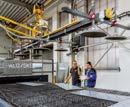



8–11/10/2024
MSV 2024
PRESENT TIMES
Mechanical Engineering in the Czech Republic is one of the pillars of Czech industry. General Mechanical Engineering – the manufacture of machinery and equipment – employs almost 115 000 highly qualified professionals, who are the most precious assets of the whole sector. General Mechanical Engineering is one of the largest employers of all Czech industrial sectors. Its manufacturing base, which is a guarantee for the permanent improvement and expansion of the product portfolio, comprises more than 6 700 companies, the production portfolios of which include a very wide range of articles of Mechanical Engineering. Mechanical Engineering is scattered all over the Republic. It often follows the metallurgical industry. That is why we encounter plenty of machine works in the Ostrava region, where heavy industry is dominant. Heavy Mechanical Engineering manufactures articles with a high weight and large dimensions, such as parts of ships, large aircraft, mining and metallurgical
technology. On the contrary, light Mechanical Engineering produces machine tools, means of transport such as automobiles and smaller vessels and numerous other smaller machines, used e.g. in the textile industry.
The Czech Republic has always been one of the leading manufacturers of means of transport and, with its tradition in the manufacture of automobiles and its suitable location, is an attractive country for investment. Moreover, this sector of the Czech economy is experiencing a long-term growth of revenues and labour productivity. An absolutely dominant position in the manufacture of means of transport is held by the manufacture of passenger cars, followed by the manufacture of buses and trucks.
An important segment of Czech Mechanical Engineering is the manufacture, repair, and modernisation of rolling stock. In the Czech Republic, there are manufacturers of all kinds of rolling stock, including Metro trains, trams, and trolleybuses. The aircraft industry is one of the top segments in Mechanical Engineering. Using stateof-the-art materials, it is becoming an initiator of technical progress in many other branches. An important position is held by the manufacture of jet trainer aircraft and light combat aircraft, regional aircraft, trainer and sport aeroplanes, gliders, aircraft components, and, last but not least, the manufacture of ultralight aircraft.
In the Czech Republic, there are also manufacturers of riverboats and short-sea ships, sport boats, yachts, motorcycles, and bicycles. Czech production also includes hot-air balloons. And what is also worth mentioning, is the Czech Space Programme. Czech Mechanical Engineering also includes the manufacture of equipment for industry and for the construction sector, the manufacture and repair
of steam and water turbines, pumps, and compressors. The Czech Republic is also a producer of machine tools and electrical hand tools, the quality of which is ranked top in the global comparison.
Czech Mechanical Engineering is traditionally an important export sector. Eighty to ninety per cent of its production are exported. In the export of goods, products of Mechanical Engineering are the source of the highest added value and are some of the best export-competitive Czech goods. In terms of the territorial structure of foreign trade, the largest business partner of the Czech Republic is traditionally Germany, followed by the UK, France, Slovakia, Poland, and Spain. The Czech Republic is also the only one of the CEE countries to be a member of the prestigious association of CECIMO (European Committee for Cooperation in the Machine-Tool Industry).
EXPORT OF MACHINERY
MEANS OF TRANSPORT FROM THE CZECH REPUBLIC IN 2022 IN BREAKDOWN BY ARTICLES (SITC 7)
A new challenge for the years to come, not only in the area of employment and education, is comprised in the “Industry 4.0” initiative. The world was changed when the steam engine and electricity had been invented. Now it is being changed by technologies, and not only in communications. For this reason, the government of the Czech Republic is going to endeavour to create an adequate environment in which it will be possible for industrial enterprises and the social milieu to develop and succeed in the new digital world. This means, in particular, to build a data and communications infrastructure, to reset the educational system, to implement new instruments on the labour market, to adapt the social milieu, and to set up a system of fiscal assistance to firms coping with investment in advanced technologies and know-how.
For example, what will the work of a lathe operator be like in 15 years? Will he normally work in a workshop with a machine in protective clothing? Or will he operate the machine by means of remote control via a computer, which will be able to give exact instructions and optimise the consumption of materials and energies and ultimately make the production most cost-effective? The philosophy of Industry 4.0 opens up unprecedented opportunities and those who are able to utilise them will succeed in the new era.
Source: Czech Statistical Office
The late 19th century was shaped by the rollout of new technologies – the combustion engine and electrical systems. In this connection, that era is sometimes referred to as the Second Industrial or Science and Technical Revolution. Most important personalities of that era included Josef Ressel, inventor of the propeller, the Veverka cousins, who invented the revolutionary “ruchadlo” plough, which cut, lifted and turned soil upside down by means of a curved plate, and Viktor Kaplan, professor at Brno University, who invented the water turbine. A personality of outstanding significance was František Křižík - the “Czech Edison”. This inventor, electro engineer and entrepreneur, invented, among other things, the electric arc lamp, improved the security system of the railways, established the first Czech power plants and, in 1881, put into operation the first electrified tramline in Prague. In 1903, he built the first electrified railway on the route from Bechyně to Tábor.
Source: www.businessinfo.cz, www.mpo.cz, www.czso.cz
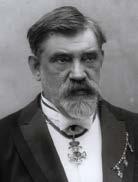



25 years on the EU market
5000+ products 5 plants


The modern engineering company ISMM is a leading supplier of top manufacturers of agricultural and handling equipment. From the TOP 10 European manufacturers of agricultural equipment, we have been serving 5 companies for a long time. The strength of ISMM is in particular the closed technological process. We are able to provide our customers with comprehensive engineering services from the design of jigs, fixtures and sample production, through primary production, welding, machining of parts to powder coating, including the final assembly. We export almost 100 % of our products to 10 EU countries, thanks to which
we achieved 1st place in the 2019 DHL Export Award in the medium-sized company category. The company has been on the market since 1997 and started its own production in 2007. Currently, the ISMM headquarters is located in Ostrava and the production is carried out at 5 sites, namely in Jistebnik, where there are two plants, then in Bravantice, Štítina, and Město Albrechtice. A total of 300 employees work for ISMM. Our portfolio consists of more than 5000 weldments and welded module sub-assemblies. We provide for our clients not only utility, but also high standards and long-term partnerships.
ISMM Production & Business Cooperation s. r. o. Pražáková 218/7, 709 00 Ostrava-Mariánské Hory, Czech Republic Phone: +420 596 113 910, E-mail: info@ismm.cz
www.ekobal.com
www.ekobal.de


Portal manipulators
High speed manipulator lines
Variable manipulator lines
Special solutions for customers
Full automatic robotic lines
Entry level robotic lines
Special robotic lines
Delta and scara robotics


KOVOSREAL Duchcov, a company engaged in mechanical engineering, is currently controlled by a sibling duo, namely Jan Kučírek and Kamila Hejduková.
You are a family business then. Which of you two steers the course you are pursuing?
Both of us. My brother and I agreed, after the death of our father, that we wanted to conduct the business so that our dad would have been proud of us. He emphasised decency and a human approach in his business. We are trying to carry on this business philosophy. In every situation, we stand up for and respect each other 100 %. That´s a principle of a functional family, by the way. We see our biggest strength in mutual trust. Another significant positive is direct management, which makes it possible for us to decide promptly and, consequently, to respond to customers´ demands immediately.

You have three manufacturing units. Is their specialisation the same or different?
The backbone of our production programme is thin sheet metal processing, predominantly on Trumpf CNC machines, as well as on eccentric, hydraulic, and press brake machines. In our powder coating plant, we process the surface of items made of iron, aluminium or zinc, while the workshop specialising in tool production is engaged mostly in the design, manufacture, and follow-up servicing of shearing, bending and hauling tools and jigs. It also produces precise machine parts according to customers' requests. As you can see, each of our manufacturing units is focused on a completely different activity.

How do you cope with the cheaper competition from abroad, predominantly from Asian countries? Our company specialises in particular in custom manufacture in the long run, so we have multi-year contracts with our customers. For example, we have been collaborating for more than 15 years with the biggest German manufacturer of hand tools. Therefore, I'm not exaggerating when I say that, thanks to similar connections, we do not actually perceive the aforementioned competition. We pride ourselves on long-term and mutually satisfactory collaboration. Our new business relationships are mostly established on the basis of the references of our current customers. And we value this fact enormously.
Where do your products mostly go? To which sectors and where territorially?
Our customers are mostly companies from the electrical engineering and refrigerating sectors. And, with our collaborative contacts, we hold a stable position in the ventilation and air-conditioning industry. We export especially to Germany.
And what is the status of your exports now?
More or less the same as before the pandemic. Fortunately, the volume of our products going abroad did not change during the pandemic. We are very pleased about this, as numerous other sectors weren´t so lucky.
You have the image of a strong and responsible employer. How is such responsibility expressed in the relationship with your employees?
We adhere to the principle that the business must be based on a high quality of interpersonal relationships. We want our company to keep a team of high-quality, responsible and loyal people, on whom we can rely. At the moment, we have 90 employees. We realise that our products are reputable, due only to them. We treat them, our colleagues, like members of our family. That´s why we invest in their working conditions, so that they can feel good working for us, and we believe in their loyalty and honesty. We do not tolerate any unethical behaviour.

What are you concentrating on most at the moment and what is the long-term vision of your business?
We are a family business and this is a kind of commitment. And, just like in a family, at work we also endeavour to achieve satisfaction for everyone, not only for our customers, but also for our employees. What is also very important to us is sustainability. Therefore, we have started the implementation of a project of photovoltaics in our company. We are still driven by the legacy of our father, who dedicated his whole professional life to this family business.
KAMILA HEJDUKOVÁ




LINEAR

















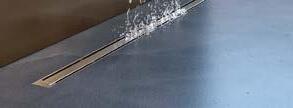








STREET DRAINS



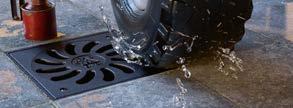


Tomáš Baťa (3 April 1876-12 July was a Czechoslovakian businessman, known as "The King of Shoes", builder of a global shoe empire, public and Mayor of the City of Zlín (1923-1932). In 1894, Tomáš, together with his brother Antonín and sister Ann, founded a shoe-making firm in Zlín , called “Baťa”, which in time he transformed into a vast complex combining production, trade, transport, services and finance, becoming one of the most significant businessmen of his time. He introduced original methods of production and busi ness management into practice, initiated an employee motivation system, and influenced a number of future economists. His methods were epoch-making at that time and are still being used as examples of top management. In its extent, his activities (35 different lines of production, trade, transport, services and finance) raised the standard of commerce in the former Czechoslovakia of that time, where the low prices of his shoes influenced the profile of the consumer industry. While building his factory compound, he also rebuilt the City of Zlín, materialising his pioneering visions. As Mayor, he pushed through the Garden City concept with its original Functionalist architecture, which spread to other locations in Czechoslovakia, other European countries and North America, where he also built his factories. He created a multifaceted educational system and motivated his employees to attend lifelong learning courses. For this purpose, he started a technical school (Baťa´s School of Work for Young Men and Young Women). As Mayor of Zlín, he initiated the introduction of experimental forms of public education. By founding a hospital in Zlín, he laid the foundations of modern healthcare in the city and the region. His vision of long-distance railway, air, river and road transport was aimed at improving the communication system within the Zlín region and the whole of Czechoslovakia. Tomáš Baťa´s lifelong support, both in private life and business, was his wife Marie, who was born in Vienna. She
was very active in the social sphere and healthcare and became a widely recognised personality in Zlín.
Tomáš Baťa University (UTB) in Zlín is another institution bearing the name of “The King of Shoes”.
In 1919, Tomáš Baťa expanded his business beyond the limits of Czechoslovakia and, since that time, Baťa shoes have been sold and manufactured in many countries worldwide. In the 20th century, the Baťa firm pursued its business activities across five continents, and it carries on its business in many countries to this day.
The Bata´s World internet portal has been created and is administered by employees in the Tomáš Baťa University Information Centre and University Library in Zlín. Its aim is to inform the public comprehensively about the existence and activities of the Baťa firm in 90 countries on 5 continents. The portal features the history and activities of the firm, starting from its founding in 1894 to the present day. All information presented on this portal is based on archival documents, professional literature, and press publications. More information at: www.tomasbata.org
Sources: Wikipedia, www.tomasbata.org
TOMÁŠ BAŤA JR.
He was born in 1914 as the only son of Tomáš Baťa, founder of the Zlín shoemaking factories. He developed the legacy of his father even further and ultimately transformed the firm into the biggest shoe manufacturer in the world. After the Nazi occupation, he operated in exile in Canada. After the War, a new centre of the shoemaking giant was established in the United Kingdom. Tomáš Baťa Jr. led the Group until 1984, when the firm was in its heyday. At that time, it had 90 000 employees and operated 90 factories and 5 000 shops in 89 countries of the world.
After the Velvet Revolution, Tomáš Baťa Jr. as an entrepreneurship icon used to visit Czechia, where he could also see the famous reopened shop of the brand on Wenceslas Square in Prague. He died in Toronto in 2008 at the age of nearly 94 years.
The energy sector is one of the most important sectors in the Czech Republic. Its strength is based not only on many years of continuous development, sophisticated use of geographically available sources, development and manufacture of machinery used in the energy sector, but also on the self-sufficiency of the Czech Republic in the production of electric energy and heat. The Czech Republic regularly ranks among the top global exporters of electricity.
The actual summary of the development, assessment, and visions of this sector for the future is provided in the document entitled “Updated State Energy Policy (ASEK)” dated 2015, valid for the next 25 years.
Primary objectives are especially the following:
n a well-balanced mix of primary energy sources and sources of electricity production, based on their wide portfolio,
n effective use of all available domestic energy sources,
n enhancement of the energy efficiency of the national economy; development of the network infrastructure of the CR in the context of CEE countries, strengthening of the international collaboration and integration of energy and gas markets in the region,
n creation of effective and operational common energy policy of the EU,
n support for research, development and innovations, providing the competitiveness of the Czech energy sector,
n support for the educational sector, focused on the necessity of generational renewal and enhancement of the quality of the technical brainpower in the energy sector,
n and, last but not least, the enhancement of the energy security and resistance of the CR and strengthening of the ability to provide necessary supplies of energies in case of cumulation of failures, multiple attacks against the critical infrastructure and long-term crises in fuel supplies.
The Czech energy sector has an excellent reputation and, with its products, is one of the best in the world. It can offer excellent quality at a favourable price. Competitive Asian firms combine their power plants
Global respect is also enjoyed by Czechia in the nuclear power sector and research. The first research reactor was already started up in the Nuclear Research Institute in Řež in 1957, which made Czechoslovakia the ninth country in a row to master the fission chain reaction. Czech nuclear research has its finger on the pulse of the future of the sector. Thanks to the good reputation of researchers and developers of the Nuclear Research Institute and its subsidiary, Centrum výzkumu Řež (CVŘ), the Czech Republic has been given the opportunity to design and realise the assembly of the unique hot chambers of the Jules Horowitz Reactor in France. The useful life of most research reactors operated in the European Union ends after 2020 (the reactors in Řež will be phased out in approximately 2027) and Jules Horowitz will assume a part of their research. In exchange for the delivery of the hot chambers, the Czech Republic gained access to a part of its research measurement capacity.
with European and US technologies. So, also in this respect, there is an opportunity to succeed in the supply chain with Czech sub-supplies. The competition offering lower prices can be beaten by Czech firms with offers of new products, and especially with consulting services on energy sector issues.
Czech firms participate in constructions of power plants and deliveries of related products almost everywhere in the world. No matter whether this is a case of nuclear, thermal, hydro- or solar-power plants. Let´s mention some examples:
n Czech firms are participating e.g. in the modernisation and reconstruction of blocks of Russian and Ukrainian power plants,
n A Czech company is going to take part in deliveries of the equipment for the control of protective systems for the Armenian power plant, Metsamor,
n A steam turbine from Plzeň will be applied on the Indonesian island of Java. The export of the Czech turbine is part of a wider project – the overall extension of the Grati power plant, involving numerous firms from various countries,
n Another Czech company, engaged in designing, construction, and operation of solar power plants in Europe and Latin America, is just finishing the construction of four solar power plants in Chile, with the total capacity of 31.4 MW. The approximate value of the completed power plants will be about CZK 660 million. The power plants are situated in the region of Central Chile around the capital city of Santiago. At present, all the power plants are already connected to the distribution network and are in the final stages of their completion. By 2023, the Czech company wants to have built at least 110 MW of photovoltaics at USD 85 million (approx-

We think of the future
We are a forward-looking company providing complete power-engineering solutions tailored to our customers' needs.
Driven by innovation, inspired by change, committed to clean energy.

Today, every day
imately CZK 1.8 billion). Other localities of the photovoltaic parks built include the Czech Republic, Slovakia, and Romania. In the Czech hydropower plant sector, there are several companies building hydropower plants not only in Europe, but also in Africa and South America. They include both projects on a greenfield site and the reconstruction and development of hydropower plants.
The power sector has always attracted top engineers, who are trying to keep moving this sector ahead. The Czech footprint was and still remains significant in this regard. Apparently the most important invention created on the Czech territory was the Kaplan turbine, which is used in hydropower plants all over the world today.
Source: Ministry of Industry and Trade, www.oenergetice.cz, www.businessinfo.cz, www.eru.cz, www.cez.cz
CZECH KNOW-HOW
The Czech Republic, together with the USA and China, are the only three countries that can boast of vast know-how regarding the application of salt technologies in the nuclear power sector. A relatively little-known fact is that a new project for the future is being born by Czech-American collaboration. The rollout of small nuclear reactors is expected in approximately 10 years. Small solar reactors have numerous advantages over the current ones – greater safety, effectivity, and flexibility.
Source: Ministry of Industry and Trade, www.oenergetice.cz, www.businessinfo.cz, www.eru.cz, www.cez.cz
Hydropower plants worldwide use the Kaplan turbine – a turbine developed by Viktor Kaplan. Kaplan was Austrian, but he created most of his significant inventions, including this turbine, in Brno, as a professor at the local German Technical University. He developed and constructed the original type of propeller hydroturbine already before World War I. He designed its blades to be narrower and in a lower number, in order to reduce friction, and with the rotating mechanism in the runner, he maintained its high efficiency even with a lower flow. Whereas the current Francis turbines achieve a speed of approx. 400 revolutions per minute, the Kaplan turbine could achieve double that speed. The first Kaplan turbine was put into operation in 1919 at a cotton mill in Velm, Austria. In Bohemia, it was used for the first time at the power plant in Poděbrady in 1921. Today, the Kaplan turbine is the most popular type in large hydropower plants on rivers with high flows and (mostly) low heads. Absolutely the highest discharge, i.e. the flow of water under certain circumstances, is achieved by Kaplan turbines at the hydropower plant in Gabčíkovo, South Slovakia: 636 m3/s, with the head of 12.88 to 24.20 metres.

















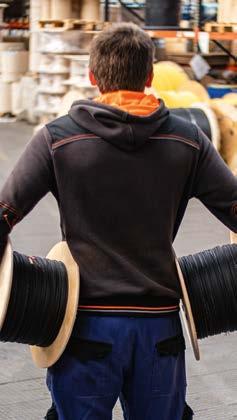























































































































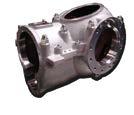
SLR SATES s.r.o. has been a member of the SLR Group since February 2023. Thanks to this acquisition, SLR SATES offers a comprehensive solution of all requirements ranging from the design of the foundry mould up to the delivery of the machined parts for the assembly.
The synergy of the Group foundries annual production amounting to 130 000 tonnes of cast iron, together with free capacities and a high potential for the production expansion on the currently available lands in Česká Kamenice, offers a solution both for small-scale and large-scale projects.
Contacts
Executive Alfons Maier a.maier@slr.de
Tel.: +49 172 7158487

Certificates:


Machine park:
Place of business
SLR SATES s.r.o. Štítného 524 407 21 Česká Kamenice Czech Republic
What is offered by us:
Foundry
• Forms
- 1000 x 700 x 300/300 mm – 20-200 kg
- 1600 x 1200 x 450/450–50-800 kg
• Material: EN-GJS 400 and higher
Machining:
Business Development Manager Jakub Špatka jakub.spatka@sates.cz
Tel.:+420 603 276 371
• Machined materials ranging from ductile cast iron, spheroidal cast iron, steel to light metals in batch to serial production
• Horizontal turning machine = Horizontal machining center
- Lathes: 40-420 x 1250 mm
- Horizontal turning centres: from 100 x 100 x 100 up to 2100 x 1500 x 1500 mm, up to 3500 kg
Our advantages
• More than 30 years of experience
• Inhouse design and manufacture of jigs
• Modern machinery with a two-pallet system
• Competitive prices at 100% quality





Gregor Mendel was born on 20 July 1822. Known for his pea plant experiments, Mendel is now regarded as the "Father of Genetics", because he discovered so much about how traits are passed from one generation to the next, despite living long before anyone had heard of DNA, chromosomes, or genes.
Mendelian inheritance refers to conditions or traits that are caused by a single gene and passed from one generation to the next in a predictable way. Mendel first observed these patterns in his garden peas, allowing him to determine the probabilities of a trait recurring across generations.
One example of a Mendelian trait would be the rhesus blood antigen – a person is either rhesus positive or negative, with no other possible options. This is different to continuous characteristics, such as height and skin colour, which tend to be influenced by many genes and cannot be predicted in the same way.
Mendel worked out that each person carried two "factors" (what we now call genes) for each characteristic, with one inherited from each parent.
In effect, he understood that his peas are what we call "diploid"(having two complete sets of chromosomes) and that their gametes (ova and pollen) contain one set each ("haploid"), so that the offspring end up with two full sets like the parents.
He also wrote that if a parent had two different versions of the gene, one half of the gametes would contain one "factor" and the other half would contain another, so both versions of a gene should have an equal probability of being represented in the next generation.
Mendel did not know about how his "factors" were encoded in cells, but his rule of "independent assortment" stated that when looking at two different traits, they would be randomly mixed up in each generation, so each gamete, while containing only half of an individual's DNA, would be a mix of genes inherited from the mother and father. This rule is certainly true for genes on different chromosomes, but can break down when it comes to genes that are

close together on the same chromosome – a phenomenon modern geneticists call "linkage".
One of Mendel’s most influential observations was that a "factor" could be dominant or recessive. If an individual had one copy of the dominant allele and one of the recessive, the person would appear to be the same as another individual with two dominant copies.
By studying traits across many generations, however, Mendel saw that the recessive factor could still be passed on, and the recessive trait would re-emerge when offspring inherited two recessive copies. Many genetic conditions display Mendelian inheritance patterns, some dominant (e.g. Huntington’s disease) and others recessive (e.g. cystic fibrosis). How a certain condition is inherited plays an important role in healthcare, helping to identify individuals that may be affected by the condition and to understand wider implications for families, including reproductive concerns.
As we continue to learn more about Genomics – far beyond what Mendel could have imagined or understood 200 years ago – his work remains a poignant and important touchpoint for our understanding of inheritance and our journey from peas to personalised medicine.
Source: https://www.genomicseducation.hee.nhs.uk

BOHEMIACHLAD Praha s.r.o. is a supplier of industrial ammonia cooling systems, industrial air conditioning systems and heat pumps, including control systems and automation, especially for meat processing plants, dairies and breweries.
We offer the full range of services, from project designing and engineering to the delivery and assembly of cooling circuits, air conditioning and heat pumps, supplied as a turnkey project.
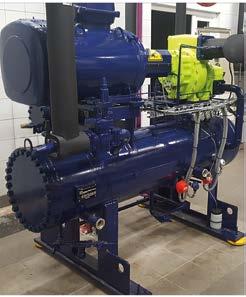



The Czech food industry is not the core of Czech exports, but some trends in the development of this sector indicate that its potential for export is growing. Such trends include the consistent and thorough control of quality, the respect for tradition, the application of the latest research results and state-of-the-art technologies in the production process and, last but not least, the development of technological, organisational, and product innovations. We believe that the Czech food industry has plenty to offer the world.
What accounts for the vast majority of the exported articles of this sector are raw materials – grain, dried milk, malt, coffee, colza oil, fodder crop, bakery products, chocolate and cocoa preparations, food preparations, beer, sugar, cheeses, and quark.
In recent years, manufacturers of food and agricultural technologies and machinery have also been successful. Exports of these technologies have headed to Belarus, Russia, Georgia, as well as Albania, Bulgaria, Kazakhstan, Mexico, Uruguay, and Ethiopia. Foreign companies in Czechia are enquiring about the purchase of equipment for bakeries, breweries, mini-breweries, dairies, and cheese production.
Other exported products of Czech firms include vegetable oil press machines, smokehouse equipment, vegetable packing lines, beverage processing and packing lines, meat processing equipment, and technologies for seed and grain processing. Deliveries of agricultural technologies and capital goods are also successful.
Czech firms abroad are also building brand-new breweries and supplying technologies for the production of raw materials for brewing. The biggest contract has been one for the construction of a brewery in Ethiopia, which was completed in February 2017. The ZVU POTEZ machine works, based in Hradec Králové, has delivered complete technologies, including construction work and spare parts worth more than CZK 764 million, for a modern plant of the Raya Breweries company.
Food producers in the CR are associated in the Federation of the Food and Drink Industries of the Czech Republic (FFDI),
established in 2001. At present, the Federation has more than 170 members, whom it represents to authorities of the CR and the EU, and to global organisations.
Priorities of this institution in terms of the market are clear: support for production quality, regional brands and local producers. One of the methods for these objectives to be pursued are awards of national food product quality labels, such as “KLASA” (“Top Class”), “Regionální potravina” (“Regional Food Product”), and “Český výrobek” (“Czech Product”), guaranteed by the Federation of the Food and Drink Industries of the Czech Republic, which are labels that guarantee the food quality. The European Designation of Origin as a certification of outstanding products is a similar tool.
Brewing has a long-standing tradition on the territory of the Czech Republic. Břevnov Monastery in Prague, which was founded in 993, has the oldest documented Czech tradition of brewing. Czech beer and brewing are world-renowned. The same is true for Czech brewmasters, who are indispensable to every brewery. Our brewmasters have worked on all continents, except for Antarctica. They have even brewed beer in places like Rapa Nui on Easter Island. Czech brewmasters have a global reputation as experienced experts, able to produce beer not only of the Czech type, but also according to local requirements.

Although this profession is rather a masculine domain, beer in the Philippines has also been brewed by a Czech female Master. Lots of Czech brewmasters also work abroad as supervisors of the licensed production of Czech Beer.
“Czech Beer” is a protected geographical indication awarded within the European Union, the purpose of which is to maintain the good reputation and quality of the beer produced on the territory of the Czech Republic. The purpose of the entry in the “Register of Protected Indications of Origin” is to protect the tradition of Czech brewing, brewing technology, beer quality, and to prevent imitations of Czech Beer being produced that may be passed off as Czech Beer and abuse its unique properties. Another reason for the protected indication is to avoid situations that a product made in the Czech Republic applying non-traditional methods, or by traditional methods abroad, is passed off as Czech Beer.
Although “Czech Beer” is a phenomenon under which every foreigner imagines similar beverages, specific brands differ from each other in taste and in production technology. A lager alone can be produced in many ways, each brewery using their own recipe, a different time and temperature of fermentation, a different place where the fermentation takes place, and a different fermentation type. Besides the large, world-famous breweries, the Czech Republic has about 400 mini-breweries and their number keeps growing. The biggest importers of our beer are Slovakia, Germany, and Poland. And as far as countries outside the EU are concerned, the main importers are Russia, Korea, and the USA.

Wines from the Czech Republic are also increasing their export potential. In Europe, they maintain their good reputation and can beat traditional champions in international contests. In addition, they also have the ambition of penetrating non-traditional markets, where people merely associate the Czech Republic with beer and sportspersons. Most Czech wines head to Slovakia and Poland, and to other countries of the European Union.
At present, the Czech food industry is experiencing a recovery and a higher progressivity after a period of stagnation. Our greatest wish is that this development will continue and gain in strength, so that Czech products and technologies will penetrate global markets to a higher extent and that Czech quality will generally become recognised and well known.
In every brewery, the Brewmaster has always been the main person to supervise the whole process of brewing, ranging from the preparation of the malt up to the final bottling. The tradition has even preserved the name of the profession, although in the contemporary Czech language, Brewmasters would rather be referred to as Chief Technologists. Besides brewing technology, this person must also possess a knowledge of the chemical processes of fermentation and maturation and, at the same time, be able to check the correct taste of the libation, so that people will find it delicious. Globally, Czech Brewmasters are much sought-after and spread the tradition of Czech beer-making throughout the world. As ideal ambassadors for their homeland, they also introduce Czech malt and hops to the countries where they work, ingredients which are indispensable for the bottom-fermented lager of the Pilsner kind. Numerous Czech Brewmasters, on the contrary, capitalise on their work in breweries abroad by bringing interesting experience, innovations and novel technological procedures back to their homeland.



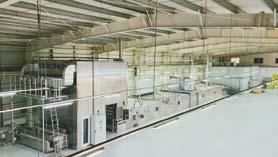

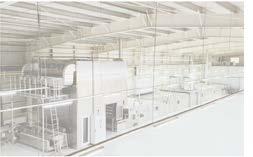



















www.comtesfht.com
COMTES FHT a.s. is a research organisation engaged in public and commercial development projects in the field of metal materials.
The company‘s premises comprise accredited testing laboratories, a metallurgical hall for prototype manufacture of alloys and metallurgical semi-products, 3D printers for metals and polymerous materials and a site for computer modelling of technological processes.
COMTES FHT SCIENCE AND TECHNOLOGY PARK
COMTES FHT Science and Technology Park is in close proximity to the laboratories. It contains an office building, a training centre with a lecture hall, a kindergarten, and a separate building with a laboratory and offices. There are office and industrial spaces for lease in this building.
COMTES FHT a.s.
Průmyslová 995, 334 41 Dobřany, Czech Republic
We are a member of the Czech Society for New Materials and Technologies, the Association of Research Organisations, the Forging Association of the Czech Republic, the Association for Heat Treatment of Metals, the Steel Strip Society, the Czech Society for Mechanics. In addition, we are also a member of the clusters of Mechatronics and Czechimplant, the Czech Technological Platform for Mechanical Engineering and the Czech Technological Platform for Additive Manufacture.
Our customers include Apple, ŠKODA AUTO, Mubea, Doosan Škoda Power, Schaeffler Technologies, CZECH PRECISION FORGE, BILSTEIN, Mubea, Voestalpine and ŠKODA TRANSPORTATION.

The current status of the Czech chemical industry is based on its long and rich history.
On the territory of the present-day Czech Republic, the chemical industry already started to develop in the late 18th century, when the oldest chemical factory in Velká Lukavice was built. In 1778, this factory started production of sulfuric acid by the thermal decomposition of alum slates. But it was not until the late 19th century that the chemical industry underwent rapid development. This era is associated with names like Jaroslav Brauner. In 1902, he expressed an assumption about the existence of the as yet unknown element with the atomic number 61. His assumption was confirmed in 1974, and the element was named promethium.
Polarography and electroanalytical chemistry are associated with the name of Jaroslav Heyrovský, who was awarded the Nobel Prize in 1959. In the 1960s, Otto Wichterle invented soft contact lenses, which became popular worldwide. In the 1980s, an important player in the development of antiviral drugs most effective against HIV was Antonín Holý, another great Czech scientist.
Today, the Czech Republic is an important manufacturer of a wide range of chemical products, including epoxy resins, PVC, ammonium sulphide, fertilisers, artificial silk, nitrous oxide, caprolactam, ammoniacal gas liquors, commodities and special amines, nitrocellulose, pigments, colourants, sodium hydroxide, and sulfuric acid.
An important role in the Czech economy is also played by the pharmaceutical industry with its large manufacturing capacity and R+D programmes. Another strong manufacturing industry in the country is the manufacture of plastic and rubber products. With the automotive industry being the biggest exporter in the country, the manufacture of tyres, hoses, V-belts, and other rubber and plastic products for passenger cars and trucks is a key part of the Czech chemical industry.
Contrary to many other countries, where manufacture is dominated by the major chemical giants, in the Czech Republic there is no leading manufacturer of chemicals. Instead, the chemical industry is the domain of small and medium-sized enterprises, which often closely collaborate in regional centres. The Czech chemical industry has many strategic advantages, such as a qualified and skilled workforce, location in the centre of Europe and a unique national network of pipelines for the transport of crude oil, motor fuels, ethylene, and ethylbenzene. The industry suffers from relatively high prices of natural gas, electricity and water, the dependence on imported raw materials (especially crude oil and natural gas) and the burden of both Czech and European legislation. It is obvious that the Czech chemical industry has many good preconditions, but it also faces multiple challenges, which include, last but not least, the fulfilment of the objectives concerning climate change and the transition from materials made of fossil fuels to a circular economy.
The Czech economy is one of the best performing, compared to all countries of the former Eastern Block. The same can be said about the chemical industry, which is not massive, but has a healthy and robust production. In the Czech Republic, there is close collaboration between the chemical industry and numerous technical universities nationwide. Like all economies, the Czech Republic is also trying to undergo essential transformations to adapt to the challenges of climate change. In this respect, it has been doing well, but there is still room for
improvement. Additional investment in the chemical industry has developed an enormously successful industry of nanotechnologies, driven by governmental support (both financial and legislative) and by the high quality of local technical universities. Therefore, the Czech Republic has a strong base of nanotechnologies with several “nanotechnological centres”, including the Prague scientific and technical cluster known as STAR.
The development and manufacture of pharmaceuticals form an indispensable part of the chemical industry. With the leading global pharmaceutical companies having entered the Czech market successfully, Czech companies have been integrated into international networks and have expanded to foreign markets. Manufacture is concentrated in the region of Prague and in the areas surrounding the cities of Ústí nad Labem and Opava. The Czech Republic benefits from its long tradition in the manufacture and development of pharmaceuticals and from the high level of experts working in this sector.
The manufacture of products from plastics and rubber is the most dynamic sector of the manufacturing industry and has a high export potential. Key rubber products are made by the biggest European manufacturer – Barum Continental – in its manufacturing plant in Otrokovice. These include tyres and hoses for the use of pneumatic tools. Other products of this sector are gaskets, V-belts, hoses, etc. The Czech Republic is a leading manufacturer of a wide range of plastic semi-products, such as file folders and packaging products. The importance of this sector consists of a close connection to the automotive and electrical engineering, construction sector and food industries, especially the manufacture of packaging products.
It is forecast that, in the next decades, significant growth will occur in two key



sectors of the Czech chemical industry, namely in the plastics and automotive industries. In addition, the outlook of the emerging nanotechnological industry is similarly promising. With a growing specialisation of the global chemical industry, with more specialised products, top chemicals, and customised chemistry, the Czech Republic is prepared for a great future.
An important role in the Czech chemical industry is played by the Prague University of Chemistry and Technology, which is the biggest educational institution of its kind in Central Europe. With its almost 200-year-long tradition and vast research projects, it supplies highly professional scientists and researchers to the Czech market. Involved in the development of new trends in the chemical industry, it enhances the image and reputation of Czech chemistry abroad.
The Association of Chemical Industry of the CR is the most important tool for the support of the Czech chemical business, associating manufacturing, trading, designing, research and advisory enterprises with relationships to the chemical, pharmaceutical, petrochemical, and rubber and plastics industries, including the Association of Paint Manufacturers, the Association of Chemical Traders and Distributors and the Czech Association of Tank Cleaning Stations. The Association closely collaborates with other organisations, associating the enterprises operating in various segments of the chemical industry, such as the Association of Plastics Industry of the CR, the Association of Czech Pharmaceutical Industry, the Czech Association of Petroleum Industry and Trade, the Czech Association for Soaps and Detergents, and the Trade Union of Workers in Chemical Industry of the Czech Republic.
“When you discover something, it is like you find a gold nugget in sand. You say to yourself: Oh, there might be a deposit, so you keep digging in the sand. And such efforts resulted in Polarography,“ commented Heyrovský on the birth of his method.

Polarography, based on the application of a dropping mercury electrode, enables the composition of even the weakest solutions to be distinguished. For his discovery, which had a huge impact on the development of electroanalytical chemistry in the 20th century, in 1959 Professor Heyrovský was the first Czech to win the Nobel Prize in Chemistry. At present, computerised polarographs are included in the standard equipment of each chemical lab. They also serve in Biology, Pharmacy, and Biochemistry. They help medical doctors to monitor some diseases, including cancer, examine DNA and proteins, and to monitor substances present in the environment. Polarography is useful, e.g. for the continuous measurement of the oxygen content in the atmosphere, measurement of the content of sulphur dioxide in smoke emissions, and the identification of the
content of poisonous metals in water. Another benefit of Polarography is the fact that it is still one of the cheapest and smartest scientific methods – it is so simple that even poorer scientific institutes can afford it.
Heyrovský was not “only” the inventor of the new method, he was also able to present his discovery successfully abroad. For example, in the USA he gave lectures about Polarography at the most prestigious universities. Already in 1929, he, together with another outstanding chemist, Professor Emil Votoček, devised and launched the Collection of Czechoslovak Chemical Communications, a professional magazine, still published today.
HE X-RAYED OBJECTS ALREADY IN HIS CHILDHOOD
Heyrovský was born on 20 December 1890 in Prague to the family of Leopold Heyrovský, Professor of Roman Law at the Czech University. He was science-curious already in his childhood. Besides chemical experiments and X-raying objects using a discarded X-ray tube, he was also interested in, for example, fossils.
Heyrovský´s interest in Physics and Chemistry prevailed when he studied at the Academic Grammar School. However, Physical Chemistry was not taught in Prague at that time, so after a year of his university studies, he left for London in 1910. His teachers were William Ramsay, Nobel Prize laureate, and Frederick Donnan, his successor, an electrochemist.
After the War, Heyrovský passed exams at Charles University in Prague, where in 1922 at 32 years of age, he was appointed as Adjunct Professor and, in 1926, as Professor of Physical Chemistry. In 1950, Heyrovský was appointed Director of the newly established Institute of Polarography (today it is the Jaroslav Heyrovský Institute of Physical Chemistry of the Academy of Sciences of the CR), which he managed until 73 years of age.
The planet 3069 Heyrovský was named in 1982 after the eminent scholar, as was a crater on the far side of the Moon (in 1985). He is also commemorated by the Jaroslav Heyrovský Foundation, which has been helping gifted grammar school students in their professional growth since 1993.
The discovery of Polarography and its spread gained him a reputation, honorary doctorates at universities and memberships of Academies of Science, including of the prestigious Royal Society of London. Heyrovský was a candidate for the Nobel Prize already in 1934, but he won it only 25 years later.
Source: www.irozhlas.cz, Wikipedie
Already many years before Czechoslovakia appeared on the map of Europe, the Bohemian Lands had a significant economic importance within the framework of the Habsburg monarchy – they accounted for about two-thirds of all Austro-Hungarian industrial production. After the rollout of combustion engines, the automobile industry, hand in hand with the production of motorcycles, started an important chapter in the history of this country.
There had been significant events to follow up on, indeed. Let´s just recall the steam car invented by Josef Božek in 1815, with which the Czech inventor took a huge step on the way towards automobiles, the Siegfried Marcus combustion-engine car manufactured in 1887 in the Adamov machine factories, and the electromobiles of František Křižík, which were built by him in the late 19thcentury.
The fundamentals for the manufacture of automobiles in the Bohemian Lands were laid down in the beautiful region under the Beskydy Mountains, in the town of Kopřivnice, where, with significant help from a Liberec factory owner, Baron Theodor von Liebieg, an automobile named Präsident was built in 1897. It was among the first of its kind in the world, like the truck that came next. Soon after came a steam omnibus, a series of other horseless carriages, as well as two electric cars and a racing car.
At that time, Václav Laurin and Václav Klement, who were successfully manufacturing velocipedes together in Mladá Boleslav, were enthused by the idea of motorising them. And it was precisely they who, in 1899, came up with the correct concept of the motorcycle. This was confirmed by a review printed in the professional magazine Allgemeine Automobil Zeitung in 1904: "By rights, we can say that the L & K firm is the creator of the motorised bicycle, without overlooking the merits of the Werner Brothers. Those French designers just connected the engine to the normal wheel without changing its shape, whereas Laurin and Klement went the other way. They built the wheel around the engine and its body. The idea was actually the same, but the difference was in the fact that the Frenchmen put an emphasis on the principle of the wheel, while the Czechs stressed the principle of the automobile. And the Czechs were right!"
From 1902, other motorcycle manufacturers started to appear on the market and, after a while, there were dozens of them in Bohemia.
In Liberec, motorcycles called Zeus were sold by Christian Linser,
One of the oldest manufacturers of automobiles in the world is Tatra, established in 1850. The Czech firm of Tatra is the third-oldest existing car manufacturer in the world with an uninterrupted production of automobiles. The only older companies are Peugeot and Benz, now Daimler AG. The first car manufactured in the Czech Republic came off the assembly line in 1898. Präsident was the first mass-produced car built in the Bohemian Lands (part of the Austro-Hungarian Empire of that time). It is one of the oldest motor vehicles in the world. On 21 May 1898, shortly after it was completed, the Präsident left the gates of the factory in Kopřivnice to undertake its first journey to Vienna, where it arrived a day later. The Präsident covered the distance of 328 km in 24 hours and 15 minutes; the actual driving time was 14.5 hours. Seeing a motor vehicle pass down the road was something absolutely exceptional, just as if today one would see a flying car!
owner of a significant engine factory. Subsequently, he also manufactured an automobile, but ultimately joined Baron Theodor von Liebieg. This venture gave rise to the RAF automobile manufacturer in 1907. High-quality, but expensive vehicles were expected to be competitors to the products of L & K. However, six years later, on the contrary, the Mladá Boleslav automobile manufacturer took the L & K business over. By that time, Laurin and Klement had taken another far-sighted step – they noticed in time that the world was going to move rather on four than on two wheels and, in 1905, their first Voituretta A automobile was built. When the production of this car came to an end in 1911, the factory in Mladá Boleslav manufactured trucks and buses, too. It seems incredible, but by 1913, up to 40 various types of automobiles bearing the L & K brand had been manufactured.
Many of them were sold successfully not only in Europe, but also elsewhere in the world, including Japan.
Thanks to Hans Ledwinka, an automobile designer, the manufacture of passenger cars and trucks in Kopřivnice was on the rise. The vehicles with avant-garde engines of the S-type enjoyed particular renown.
It may be worth mentioning some figures characterising this era. Early in the 20th century, the annual salary of a workman was about 1 200 crowns, a janitor was paid about 1 500, a glass-blowing craftsman up to 4 000, a schoolmaster earned about 7 000, clerks from 6 000 upwards. So when, in 1905, for example, the first A-type Laurin automobile was sold for 3 600 crowns, automobiles, except
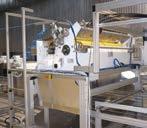

tech@gfm.cz www.gfm.cz

casopis.indd 2
for luxury ones, did not have to be unaffordable items. And there were also cheaper models available, because the manufacture of automobiles was also taken up, although in some cases just for a short time, by other firms. Czech automobiles gained admiration in many countries of the world. Nevertheless, their sales could not compare to those of neighbouring Germany, mainly due to various official regulations and expensive petrol. For motorcycles, the situation was fortunately much better. This was despite the fact that Bohemia with Moravia belonged to the minority of countries where the manufacture of motorcycles and automobiles had taken hold.
Thanks to its unique geographic position, good infrastructure and qualified workforce, the Czech Republic plays an important role in the automotive industry. Per capita, it is a leading manufacturer of buses, and ranks second in the global comparison in the production of passenger cars. Having a capacity and sources

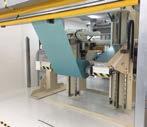

12.03.2023 13:50:41
for three main car manufacturers – Škoda Auto (Volkswagen Group), TPCA (joint venture Toyota / Groupe PSA), and Hyundai Motor Manufacturing Czech – and excellent business opportunities for suppliers, the Czech Republic is prepared to strengthen its position as one of the leading European centres for the automotive industry in the area of design, research and development. The country´s 100-year tradition in mechanical engineering, intensive collaboration with Czech universities in the hightech area and governmental support make the Czech Republic an ideal destination for future mobility. Every year, more than 85 % of the total automotive production of manufacturing plants in Czechia is exported.
The automotive milieu in the Czech Republic also includes numerous suppliers, who are focused in the first place on the manufacture of components, electronic equipment, and other accessories for motor vehicles. In addition, the manufacture of automobiles influences other industrial sectors, such as mechanical engineering, the manufacture of electrical equipment, the rubber industry, and the plastics industry.
The automotive industry also remained a driver of the economy in COVID times, despite the fact that the automotive industry was hit hard by the coronavirus pandemic.
AutoSAP is a voluntary association of companies involved in the production chain of the automotive industry of the Czech Republic. It also associates research and educational institutions and similar entities or individuals keen on actively contributing to the development of the Czech automotive industry. It sets up a platform for their mutual communication and support of their common goals.
DESPITE EXTENSIVE CHALLENGES OF THE YEAR, A TOTAL OF 1.25 MILLION VEHICLES WERE MANUFACTURED IN THE CZECH REPUBLIC IN 2022
The Czech automotive industry faced numerous uneasy challenges in 2022. Despite a persisting lack of semiconductors and other components, the war in Ukraine, difficulties in manufacturing and logistic chains, a total of 1 249 281 road vehicles of all kinds was manufactured from January to December 2022. After three years of declining volumes of the production, the Czech automotive industry experienced a 9.4 % increase in production again. A year-on-year increase in production was experienced by the manufacturers of passenger cars: +10.2 % (1 217 787 vehicles), buses: +7.6 % (5 322 vehicles), trucks: +6.7 % (1 347 vehicles), motorcycles +56.9 % (1 624 vehicles), and big trailers and semi-trailers over 3.5 tonnes: +11.2 % (2 441 vehicles).
A production decline only occurred in the category of small trailers and semi-trailers up to 3.5 tonnes: -23.2 % (20 760 vehicles). With the total production of 134 944 electric passenger cars and 56 electric buses, the segment of vehicles with electric drives exceeded 11 % of the total production of motor vehicles in 2022.
Passenger Cars
In 2022, a total of 1 217 787 passenger cars were produced in the Czech Republic. In the year-on-year comparison, this is 10.2 % more than in 2021. 87 736 cars were intended for the domestic market, which is 9.7 % less than in the previous year. More than 92 % cars (1 130 051 vehicles) were intended for foreign markets. This means that the export of vehicles, on the contrary, experienced a 12 % growth in the year-onyear comparison.
In 2022, ŠKODA AUTO manufactured a total of 693 032 vehicles (+1.9 %) in its domestic manufacturing plants. 71 152 vehicles (-11.0 %) were placed on the Czech market and 621 880 vehicles (+3.5 %) were intended for foreign markets.
In the year-on-year comparison, the Toyota factory in Kolín did exceptionally well. Despite the chip crisis, they increased production in the year-on-year comparison by 34.9 %, up to a total of 202 255 vehicles. A significant growth was experienced by Toyota, both on the domestic market (+96.5 %), and in export (+34.4 %).
The Hyundai factory in Nošovice was also doing well. In 2022, they manufactured a total of 322 500 vehicles (+ 17.3 %), including 308 243 vehicles exported (+19%) and 14 257 placed on the domestic market (-10.9 %). TUCSON, the most popular model on the long-term basis, accounted for more than 70 % of the production.
The total number of passenger cars manufactured included a total of 134 944 electric vehicles, which corresponds to their 11.0 % share in the total production. 87 086 vehicles (i.e. 7.2 %) were battery electric vehicles and 47 858 (i.e. 3.9 %) vehicles were plug-in hybrids (PHEV). The share of electric vehicles in the production of ŠKODA AUTO was 10.4 %; in the production of Hyundai, it was almost 20 %.
In 2022, 5 322 buses (+7.6 %) were manufactured in Czechia, including 649 vehicles (-5.5 %) for the domestic market; the remaining 4 591 buses were exported (+0.0 %). The factory of IVECO CR in Vysoké Mýto produced 4 766 buses, which is 9.2 % more than in the previous year. SOR Libchavy produced 520 buses (-5.8 %), including 42 vehicles with a purely electric drive (which is an 8.0 % share).
Š KODA Electric manufactured 14 buses last year.
TATRA Trucks, a company which is the only manufacturer of trucks among members of the Automotive Industry Association (AutoSAP), had another successful year. In 2022, they manufactured 1 347 vehicles, which is 85 vehicles (+6.7 %) more than in 2021. The
production of Tatra was intended both for export (629 vehicles), and for the domestic market (697 vehicles).
The production of motorcycles of the “JAWA Moto” make also increased in 2022. A total of 1 624 motorcycles manufactured means a significant year-on-year increase of 56.9 %. Jawa did well, especially on the Czech market, where 1 017 motorcycles were sold (+28.6 %). 607 motorcycles were exported (+148.8 %).
As far as the segment of trailers and semi-trailers is concerned, a total of 23 201 trailers and semi-trailers were manufactured, which is 20.6 % less in the year-on-year comparison. The total decrease in the segment is especially attributed to AGADOS, a company manufacturing small trailers up to 3.5 tonnes. In 2022, AGADOS produced a total of 20 760 trailers of this kind, which is 23.2 % less than in the previous year. 11 570 trailers were sold in Czechia (-30.0 %), while 9 742 were exported (-3.6 %). A year-on-year increase, on the contrary, was experienced by manufacturers of big trailers and semi-trailers. PANAV manufactured 475 such vehicles, which is 63 more than in the previous year (+15.3 %). They sold 390 vehicles in Czechia; 78 vehicles were exported. The production of Schwarzmüller also increased. In 2022, this company produced 1 966 big trailers and semi-trailers (+10.2 %), including 776 vehicles placed on the domestic market, which is the same number as in the previous year (+0.0 %), and 1 665 vehicles were exported (+19.2 %).
Source: www.autosap.cz

How do the long impacts of the pandemic and economic consequences caused by the war conflict in Ukraine show themselves on the Czech logistics market? Are companies essentially changing their internal logistics plans? These questions are answered in a new study titled "Czech Logistics Trends of 2022", which has been carried out for SKLAD by Ipsos, a research agency. Within enquiries and indepth surveys, 132 managers of logistics and warehouses across various segments have shared their opinions about what is influencing them most and what they are struggling with at the moment in their practice. The study follows up on a successful version of the 2020 study.
DESPITE SAVING, 95 % OF COMPANIES FIND IT CRUCIAL TO INVEST IN AUTOMATION IN 5 YEARS
Interviews with experts have shown that companies are not able to plan as they used to. The pressure on effectiveness is leading to digitalisation and tendencies towards complete warehouse automa-
tion. Companies are trying to find ways of cutting energy costs. The surveys have shown that especially companies engaged in automotive business are saving: 72 % of the respondents from the automotive sector answered "yes" to this question. The price and availability of components are a problem for 54 % of respondents. Despite these facts, 95 % of the companies asked are planning at least a partial automation of warehouses. In the survey two years ago, only 89 % of companies planned to automate. In the nearest future, 68 %





of respondents are interested in warehouse analysis and optimisation. The same percentage also want to invest in warehouse equipment with advanced technologies. The most topical issues in this regard are fully automated handling devices, robots, and predictive analysis. Occupational safety is important to 67 % of respondents. 52 % of respondents are planning to implement a WMS. 45 % of the companies asked want to find new warehousing spaces. 25 % of respondents are going to solve the issue of guarding.
In connection with the consequences of today's social and economic situation, the topics of IT security, technologies' protection and supply-chain optimisation resonated with experts more strongly than in 2020. "IT security is connected with the pressure on warehouse digitalisation. Logically, a higher degree of automation brings about higher demands on cyber protection. Some companies are also contemplating choosing a supplier in Europe, to minimise the risk related with supplies from other parts of the world," says Barbara Hrabalová, Head of the of Ipsos Actify Department, about the two new trends.
The study comes to the conclusion that the present turbulent time does not show any essential deviation from the tendencies of internal logistics towards complete warehouse automation; it is rather accelerating this transformation. Companies are searching for ways of cutting costs, not only by means of simple reduction of energy consumption, but also by means of optimisation of the movement of goods and the utilisation of human labour force in warehouses. "The surveys have clearly shown that what is planned most often is investment in technologies, with a practi-

cal and fast impact on the effectiveness of the whole process, for example in automated handling devices. There is also a higher demand for detailed data analytics of warehouses. Where Czech logistics will move depends on what is going to happen to us in the next one or two years," concludes Petra Troblová, Executive Manager of SKLAD Association.
Source: SKLAD Association

Works L&W group, s.r.o., was founded in Hradec Králové in 2011. We are a successfully developing Czech company without foreign participation, specialising in the field of production-assembly works, both with domestic customers and abroad (e.g. Hungary, France, Norway, Finland, Great Britain, the Faroe Islands, Slovenia, Slovakia, Spain, etc.) Our services are used in the food, pharmaceutical, chemical, petrochemical, and other industries.
Our company has bought a brownfield as our new headquarters, which has been reconstructed with the assistance of EU funding. We moved to the new premises in early February 2020. The new complex is over 8 500 sq.m in size, where we have built a brand-new production hall (1 500 sq.m) with a 5t bridge crane & CNC plasma cutting machine to improve production flow and to expand capacities. In addition, our new main office building is more modern, providing adequate space for our requirements

“We do work we like, work that has
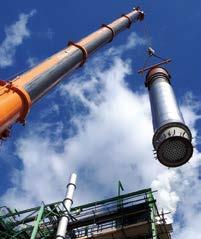
We employ an average of 60 to 80 people. In our work, we collaborate with Czech and foreign subcontractors. Apart from our own employees, we also engage self-employed persons and agency workers.
Our business programme includes:
Installation of technological equipment
Manufacture and installation of piping systems
Manufacture and installation of steel structures
Custom production
CNC plasma cutting machine
Reinstallation of fabric and SS or CS compensators (dismantling and assembly of new ones)
Turnkey realisation of investment units
clearly visible results and work which requires thinking”
We provide quality services and hold a variety of certifications, meeting the requirements of e.g. the 2014/68/ EU directive A2 module and the WPQR certificate, etc. Needless to say, we emphasise strict adherence to safety regulations, with health and environmental protection taking precedence over all our other activities.
Our customers: Grainetec A/S (DK) (installation of tech. equipment and piping – fish feed factory –Skretting A/S – Norway, Scotland, Faroe Islands), Saint-Gobain Construction Products CZ (CZ), CS Cabot (CZ), Unipetrol-RPA (CZ), Nestlé (CZ), Stock Pilsen (CZ), ASC Process Systems Ltd. (GB), ZVU Engineering a.s. (CZ), Steap Stailor (FR), Izotechnik SP z.o.o. (PL), TSI (FR), OMYA (CZ), TPI (FR), GEA (FI), ClonBio (HU), INGTOP (GB). Vodňanská drůbež (CZ), STIB (FR), ALLIA (FR), and many others.
Modern industrial stock in the Czech Republic nearly reached 10.8 million sq.m Over one-half of the space currently under construction is in the Karlovy Vary, Plzeň, and South Moravia regions.
Out of 1 200 000 sq.m currently under construction, 60 % is already pre-leased.
The vacancy rate increased by 26 basis points compared to the previous quarter. However, this still represents a 10-basis point decrease compared to Q4 2021.
Prague’s average highest achievable rent has again increased to the new level of €7.65 per sq.m per month.
The modern, developer-led warehouse stock in the Czech Republic reached almost 10.8 million sq.m, and we expect that, by the end of Q1 2023, it will surpass 11 million sq.m. Approximately 167 300 sq.m were newly delivered to the market in Q4 2022 within 12 industrial parks across the country. This figure represents a 66 % decrease compared to the previous quarter.
There are two major reasons for this: firstly, several projects which were expected to be completed in 2022 were postponed to the following year and, secondly, in the last quarter, we saw the completion of Amazon’s 187 000 sq.m distribution centre, which affected these figures further. Compared to the same period of the previous year, this is however still an increase of 10 %. More than 1 100 000 sq.m of new industrial space were delivered in 2022, which represents an increase of 121 % compared to 2021. This is the highest amount of space ever to be delivered to the market within a single year.

The most significant completion in Q4 2022 was in VGP Park Olomouc (39 200 sq.m), which at the time of completion was fully leased to a logistics company. The second-largest completion was in D2 Logistics (22 000 sq.m), which was fully leased to a company from the automotive sector. The largest completion in 2022 was the completion of Amazon’s new 187 000 sq.m distribution centre in the Olomouc region near Kojetín.
At the end of Q4 2022, the total space under construction in the Czech Republic amounted to the level of 1 219 000 sq.m, representing an increase of 4 % compared to the previous quarter and an approximate 7 % increase compared to the same period last year. Approximately 26 % of that space is situated in the Karlovy Vary region, followed by the Plzeň region with 15 % and 12 % in the South Moravian region. During Q4 2022, development works commenced on a total of 213 200 sq.m of industrial space. The share of speculative space under construction increased to 40 % during the quarter. In 2023, the overall new supply is expected to exceed 1.0 million sq.m. With this, there is a possibility that, by the end of 2023, the stock in the Czech Republic might exceed 12 million sq.m.
During Q4 2022, gross take-up, including renegotiations, reached 354 000 sq.m. This represents a decrease of 27 % compared to Q3 2022 figures and a 45 % decrease compared to Q4 2021. During Q4 2022, the share of renegotiations accounted for 35 %, an increase compared to the previous quarter (27 %).
Net take-up in Q4 2022 totalled 231 300 sq.m, showing a decrease of 35 % quarter-on-quarter and quite

www.zonaholesov.cz
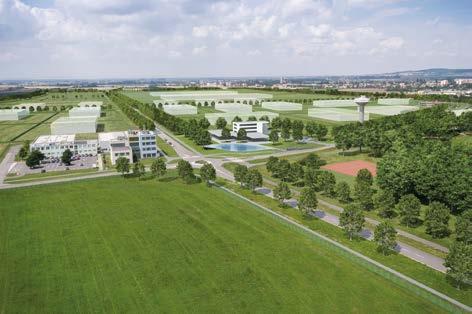
Building Plots 0.5 – 80 ha large
Excellent Transport Infrastructure
Utility Networks Brought up to the Border of the Plot
a notable decrease of 48 % year-onyear. Net demand (excluding confidential/undisclosed deals) in the fourth quarter was driven mainly by manufacturing companies, accounting for 59 % of the volume, followed by logistics companies with 31 % and distribution companies accounting for 10 %. In terms of volume, net take-up in Q4 2022 was the lowest volume recorded on the Czech industrial market since Q3 2020, when take-up volumes reached 165 600 sq.m. For the entire year, gross take-up reached 2 209 700 sq.m, which represented a decrease of 10 % compared to 2021 and an increase of 45 % compared to 2020.
The most prominent new transaction in Q4 2022 was a new lease of 17 000 sq.m in Industrial Park Rosice, signed by an undisclosed company. The second-largest transaction was pre-lease of 10 500 sq.m in Garbe České Budějovice, signed by Taconova Production. The third-largest deal in Q4 2022 was
a pre-lease of 10 200 sq.m in VGP Park Ustí nad Labem signed by an undisclosed company from the automotive sector. The largest renegotiation in the fourth quarter was in P3 Lovosice, where FM Logistics signed a 60 600 sq.m renegotiation with P3. In addition, there were several even larger new transactions on the market throughout the quarter. However, for reasons of confidentiality, we cannot disclose any details of these transactions.
At the end of Q4 2022, the vacancy rate in the Czech Republic reached 1.18 %, which indicates current resiliency of the Czech industrial market, despite the ongoing crisis. In comparison, this is a small increase of 26 bps compared to the previous quarter and an even smaller reduction of 10 bps compared to Q4 2021 levels. A total of 127 100 sq.m of modern industrial premises is available for immediate occupation. The vacancy in industrial warehouse space in the Greater Prague region is even more constrained than the national rate, resting at close to 0 % since Q2 2021.
Prime headline rents have increased to the level of around €7.50– €7.90/sq.m/month in the Czech Republic in Q4 2022. Some special offers, especially in Prague, start at €8.50 per sq.m/month. Selected prime locations outside of Prague have now seen their prime rents grow at a faster pace than ever before and are around €6.00/sq.m/month. Rents for mezzanine office space stand between €9.50–€12.50/sq.m/month. Service charges are typically around €0.65–1.00/sq.m/month.
https://www.msn.com/cs-cz/
The glass industry has a very long tradition in Bohemia. It was developed especially in its mountain regions, due to the abundance of raw materials available there. The first glass factories were set up in the late 13th and early 14th centuries.
On the territory of Bohemia, glass factories or rudiments of glass factories have always occurred in localities with sufficient fuel, i.e. in or near forests. Most of today´s glass factories are still in sites of the former historical ones. The best-known glass factories are in the Liberec region, where they predominantly produce utility glass and jewellery. The area of the Jizerské hory Mountains and the Lužické hory Mountains is also called “Crystal Valley”. Some of the glass factories there date back to the 16th century. There are also glass schools, universities with design specialisations, and the unique Museum of Glass and Jewellery. Nowhere else in the world is there such a concentration of glassmakers. Other localities of the glass industry are, in particular, the Krušné hory Mountains, the Krkonoše Mountains, the Jeseníky Mountains, the Šumava, and the area around Zlín in Moravia, where mostly container glass is manufactured. At present, the glass industry employs about 17 500 people. An important role in the development has always been played by Bohemian glass dynasties, which influenced technological development in the whole of Central Europe. The art of melting glass used to be a family secret, which was passed on from father to oldest son. The most important feats of Czech glassmakers include the manufacture of the deep-blue coloured glass, known as “smalt”, prepared by including a cobalt compound, invented by the Schürer family in Northern Bohemia in the 16th century, and the invention of Bohemian crystal in the Müller glass factory in the Šumava in the 17th century. The invention of lasure and hyalite glass is credited to B. Egermann in the early 19th century.
At present, the production range of the glass industry covers the following manufacturing branches: flat glass, container glass, glass fibres and products made of them, utility glass, (including e.g. beverage glass, decorative glass, and artistic glass), and other special glass, such as glass apparatuses, laboratory glassware, glass components for screens, technical glassware, protective glass for welding, optical glass, semi-products for jewellery, and cement and glass blocks called “Luxfer” used in the construction sector.
In the Czech Republic, there are about 40-50 independent firms
The Ministry of Culture of the Czech Republic has decided to add the “Craft Manufacture of Glass“ to the List of Intangible Cultural Heritage of the Czech Republic. This action is the essential condition for the possibility of filing the application for the addition to the UNESCO List of Intangible Cultural Heritage of Humanity. The initiators were representatives of the Museum of Glass and Jewellery in Jablonec nad Nisou. The documentation for the joint nomination is being prepared by France, Germany, Spain, Hungary, and Finland, together with the Czech Republic.
manufacturing and supplying furnaces, machinery and equipment, glass moulds and devices, which serve for the manufacture of glass and ceramics. In addition, there are providers for servicing, designing, expertise and advising for this sector.
The long-standing tradition and development of the manufacture of glass, porcelain and ceramics are also conditioned, besides other factors, by a sufficient quantity of basic raw materials, including sand, kaolin, feldspar, and silica. High-quality glass sands with an extremely high content of SiO2 are excellent for the glass industry and for various kinds of applications in other sectors, too. The sands are delivered wet or dried.
The highest volume of production is currently achieved by flat glass for the construction and transport sectors, followed by container glass for the food and chemical industries. Nevertheless, also the manufacture of hollow glass, standard and luxury decorative glass and modern lighting is doing very well in the Czech Republic.
Important export articles include Bohemian glass in the category of “household glass”– which is relatively ordinary, and intended for normal use. In addition, lead crystal, cut lead crystal, decorated with painting, penand-ink drawing, lasure, high enamel, or engraving, is an important export item. This category also includes glass figurines. Exported articles also include hand-made utility glass and historical replicas. Czech products are mostly exported to the EU countries and to a total of more than 180 countries worldwide. Glass articles that are exported to numerous countries worldwide are in general called “BOHEMIAN GLASS”. Luxury goods include e.g. iconic crystal chandeliers, which can be seen in Versailles, St. Petersburg, London, Dubai, Macau, and New York.
Source: Czech Radio, Association of Glass and Ceramics Industry















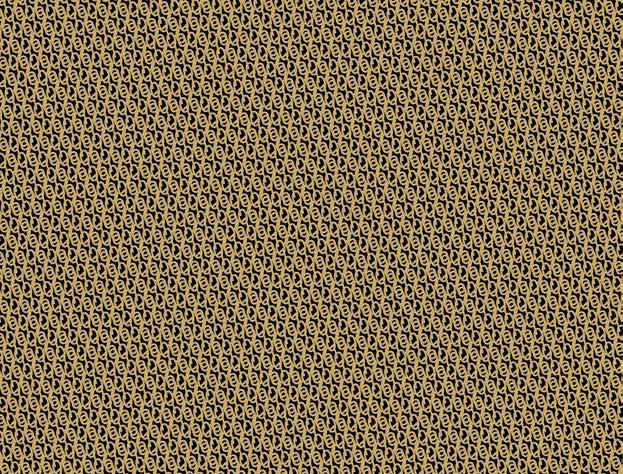
Ifyouhave musculoskeletalsystemdiseases, neurologicaldiseases,circulatorysystemdiseases,diabetesmellitus, skinproblemsorBechterew´sdisease,
HotelRadiumPalace**** -impressiveneoclassicalbuildingsurroundedbyforestpark -traditionsince1912 -finediningrestaurant -extraordinaryhealingeffects -reputablemethodsofrenownedCzechphysiotherapy -uniquetreatmentthroughradonbaths
The Czech Republic is one of the countries offering vibrant tourism. The country with its population of 10 million is a peaceful and safe destination, with plenty of historical monuments, picturesque landscape, world-famous spas, and a network of luxurious hotels and facilities for leisure activities. Czechia is also becoming popular as a venue for congress tourism, the capacities for which are especially adapted in big cities.
In general, the Czech Republic is one of 30 countries worldwide regarded as the most suitable for congress tourism; the Czech metropolis of Prague even ranks among the 15 most popular cities. This ranking is also supported by the successful organisation of several conferences of global importance, which have been hosted by Prague in recent years. A stable economy, strategic position, favourable climate, various points of interest, and a high quality of services provided in congress facilities are the factors making Prague an attractive congress venue. Prague has modern hotel facilities with a wide range of conference rooms and state-of-the-art technology. The Prague Congress Centre has undergone vast modernisation. In addition, Václav Havel International Airport, where a multitude of international flights of renowned airlines and numerous low-cost carriers arrive every day, is extending its capacities and services.
The history of the Czech spa industry dates back hundreds of years. In the course of time, spas have been places of healing and relaxation, visited by many important personalities in the social, cultural, and political life, from J. W. Goethe to F. Kafka, F. Chopin and former presidents T. G. Masaryk and Václav Havel. Even King Charles the Fourth regularly enjoyed the beneficial effects of spa stays. In the late 19th century, Czech spas were so famous that they were referred to as the “salons of Europe”. Today, the Czech Republic is one of the global spa empires, with high-quality spa facilities actually scattered throughout all regions of our Republic.

Czech spas are famous for high-quality medical care and progressive therapeutic and rehabilitation methods. Credit for the excellent performance of the Czech spa industry can be given especially to the highly qualified staff (medical doctors, physiotherapists, nurses), which is one of its main strengths. It is not by chance that in 2006 a spa in the Czech Republic was actually the first in Europe to be awarded the certificate of EUROPESPA med© – the prestigious acknowledgement of quality from the European Spas Association in Brussels, given to selected European spas after demanding examination and auditing of their operations. At present, Czechia is a country with the highest number of successfully issued certifications within the EU.
The Czech Republic has hundreds of natural healing springs and rich deposits of peloids (mud/peat), sources of mineral spring gases and locations with a favourable climate. In combination with medical science, this has given rise to more than 30 Czech spas treating a wide range of illnesses.
The Jáchymov Spa is a very famous spa centre, where the first spa with radioactive waters was established. At the beginning of the 20th century strong radioactive springs were discovered there and subsequently in 1906, the first radon spa in the world was established. The spa was established after Pierre and Marie Curie, Nobel Prize winners, had isolated the first radioactive elements – polonium and radium – from the waste from the Jáchymov uranium ore, the uranite. The thermal and radioactive springs improve the condition of patients with metabolic disorders, ailments of the nervous system, locomotive system disorders. Metabolic illnesses (diabetes and gout) are also treated here, as well as age-related illnesses. More at www.jachymov.cz

Experts constantly warn that overuse of drugs may have plenty of adverse side effects. Fortunately, today´s society is starting to return to well-proven natural procedures and to try the healing effect of centuries-proven natural sources, whereby treatment significantly less invasive than treatment with drugs or radical irreversible surgery is available.
A spa cure has a provable revitalising influence and heals numerous illnesses. Positive effects appear not only during the spa stay, but also continue for several months thereafter. This is also the reason why people attend spas regularly.
Besides therapeutic and wellness procedures, our spas provide numerous other opportunities for sport, social and cultural entertainment. Magnificent scenery surrounding most of our spas lures visitors to go walking and trekking, clients have swimming
The Spa Triangle - Karlovy Vary, Mariánské Lázně, and Františkovy Lázně – together with another eight famous European spas – has been added to the UNESCO World Heritage List, upon the international series nomination of “Great Spas of Europe“.
pools, fitness centres, tennis courts, bicycle rental services, and numerous other sporting facilities at their disposal. Culture fans can also enjoy themselves. There is a wide variety of concerts, theatrical performances and other cultural events held in the spas to choose from. Many spas also boast of a rich history and interesting architecture.
Besides traditional therapeutic stays, each spa offers some preventive, relaxation and wellness stays, anti-stress programmes for executives, beauty programmes for women and stays focused on weight loss. The length of stay can be selected according to one’s time possibilities – the most popular are one- or two-week stays, weekends and long weekends.
Source: www.lecebnelazne.cz

Whatever your answe r is, Karlovy Vary will definitely live u p to your expectations. The town will thrill all visitors with its unique architecture, thanks to which, together with other European spas, it has been added to the UNESCO World Heritage List (The Great Spas of Europe). But what really makes Karlovy Vary unique are the local thermal spr ings. Thirteen springs are used in the treatment of diseases of the digestive tract, diabetes, gou t, and diseases of the large joint s. Visitors arrive in the spa town not just to heal their ailments, but also to discover the historical and natural beauties of this locality. The region of Karlovy Vary is packed with a v ariety of points of interest, in addition to t he thermal springs.
Kriváň, Slovan, and Concordia Spa Hotels – 3*-standard accommodation
Ideally situated in the city centre, just a few steps from the colonnades with mineral springs
Modern balneotherapy practice, offering more than 45 procedures based on thermal mineral water and peat
Balneotherapy programmes focused on the treatment of the digestive tract, gout, diabetes, and motor system disorders
Relaxing, revitalising, wellness, and hotel stays
Bohemia-lázně a.s.
Spa hotels Kriváň – Slovan | Sadová 5 | 360 01 Karlovy Vary | Czech Republic
Phone: +420/ 352 511 111 | Fax: +420/ 353 228 220 accommodation@bohemia-lazne.cz
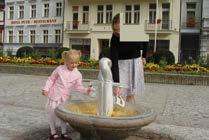
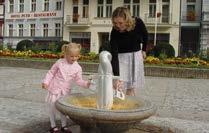




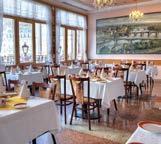
The Karlovy Vary Region has served as a crossroads of European cultures since time immemorial. Its distinctive features include the exceptional ambiance of spa towns, therapeutic hot and cold springs, enchanting architecture reminiscent of fairy tales, numerous historical monuments, expansive spa forests, and picturesque countryside. The globally renowned towns of Karlovy Vary, Mariánské Lázně, and Františkovy Lázně boast a well-established infrastructure and impeccable services. With excellent accessibility and a comprehensive transportation network, the region is ideally suited for organizing MICE events (Meetings, Incentives, Conferences, Events/Exhibitions). Adequate space capacity accommodates events ranging from 50 to 7,000 participants across 35 conference venues, each equipped with numerous high-quality services. In response to the dynamic market, local event suppliers incorporate innovative practices to enhance the overall experience.


10 COMPELLING REASONS TO SELECT THE KARLOVY VARY REGION FOR YOUR MICE EVENT:
n In the centre of Europe, world-famous spa towns listed by UNESCO await you.
n Enjoy seamless accessibility and a well-developed infrastructure, complete with an international airport.
n Choose from a range of hotels spanning all categories, where tradition and history merge with exceptional service standards.
n Discover congress rooms of various sizes, consistently staffed by qualified professionals offering a personalized and professional approach.
n Benefit from extensive experience and a rich tradition in hosting MICE events.
n Explore a diverse array of supporting programs, including spa and wellness activities, cultural and sports events, fostering a unique and memorable experience.
n Immerse yourself in the genius loci of UNESCO-listed spa towns with their unique atmosphere, distinctive architecture and historical monuments.
n Indulge in a vibrant cultural scene with theaters, cinemas, concerts, museums, galleries and festivals.
n Experience the highest concentration of golf courses in the Czech Republic.
n Rest easy in the knowledge that the Karlovy Vary Region is a highly secure destination.
We eagerly anticipate the next chance to craft memorable meeting and stay experiences for you in the Karlovy Vary Region.
www.visitvaryregion.com www.carlsbad-convention.cz
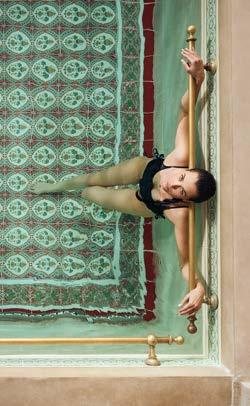

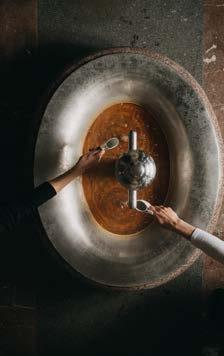
www.visitvaryregion.com

One of the fastest growing export commodities in the Czech Republic is the export of a wide spectrum of medical supplies and devices for equipping hospitals. The presentation of Czech producers abroad owes much to the fact that the Czech Republic is a country with a strong healthcare system covering all the fields of modern medicine.
On the territory of the Czech Republic, healthcare offers a wide range of outpatient facilities, hospitals and medical institutions under the patronage of not just the state, but various private entities as well. Czech companies rank among the best in the field of the manufacture and supply of medical materials, devices, and equipment for hospitals. Every year, their products travel to a number of countries worldwide. Outside of European Union countries, they find their way to the Commonwealth of Independent States, territories in south-eastern Asia, the USA, and recently also to Africa, among others. Czech companies are finding an increasingly solid foothold by supplying products and devices with added value, meaning with a high contribution from research, electronics, and information technologies. Czech exporters focusing on medical supplies of all kinds are successful in acquiring lucrative contracts for providing not just individual goods and services, but for equipping entire hospitals, health centres and healthcare chains, including the construction of such facilities. Examples of these can be found in Ghana, Gabon, Laos, Algeria, Trinidad and Tobago, Papua-New Guinea, Columbia, and even Russia and Kazakhstan. For instance, they had a hand in building three hospitals
in Gabon and ten health centres in Ghana alone.
A number of Czech suppliers of medical equipment have entrenched themselves in highly competitive foreign markets in recent years. These companies put emphasis primarily on three key factors: Research, leading to reaching high technical parameters; Design, aiding in selling the product; and Quality, resulting in the products' reliability. A combination of all these criteria can be found, for instance, in medical instruments and traumatological implants, rehabilitation and transport equipment, medicinal and technical gas distribution systems,
stabilisers, cobalt radiators, anaesthesiological equipment, and adjustable hospital beds.
The majority of this is equipment for operating theatres and inpatient wards. The world leader in this segment is the Linet Group, supplier of medical and nursing beds, furniture, anti-pressure-sore mattresses and more. The company has expanded its range of products with birthing, gynaecological and dialysis chairs.
Of course, Linet is not the only Czech company to find success on foreign markets. The majority of such companies believes strongly in running their own development, indicating that this is the way to beating the competition.
Many successful Czech exporters are members of the Association of Producers and Suppliers of Medical Devices (AVDZP). The Association unites over 100 leading Czech companies from the field. Members of the Association cooperate with a number of research departments of universities, such as the Czech Technical University in Prague, Brno University of Technology, Tomáš Baťa University in Zlín, and Masaryk University in Brno. This serves as further evidence of the attention Czech producers pay to the quality, competitiveness, and technical advancement of their medical equipment.
Some of the unique products they export abroad are, among others, degradable stents for the digestive tract, a wide range of steam, hot-air, and chemical sterilisers, lab dryers and incubators. The companies are not only limited to those, however, as they also supply a variety of physical therapy equipment, e.g. electrotherapy devices, sonography devices, lasers, and devices for lymphatic drainage therapy. They also export complex systems for biological protection, logistics, and decontamination systems and equipment for urgent and long-term care medicine. The majority of Czech manufacturers of medical equipment export most of their core production. This indicates that they are succeeding on the world market. Many Czech companies are following suit, managing to develop and continuously successfully export unique products and patented goods worldwide.
Source: Association of Producers and Suppliers of Medical Devices (AVDZP), Businessinfo.cz

THE CZECH PROJECT COULD ASSIST PATIENTS WORLDWIDE.
ARTIFICIAL INTELLIGENCE WILL BE INSTRUMENTAL IN DIAGNOSTICS.
X-ray images of the lungs may soon be interpreted with the use of Artificial Intelligence. The Carebot system, devised by Czech system developers, is able to interpret a chest X-ray with high accuracy and even to generate a brief medical report. The Carebot project founders, Daniel Kvak and Matěj Minář, together with Anna Chromcová, Medical Director of the company, are working hard on the development of this Artificial Intelligence, which could be of global benefit in the future. Currently, the Carebot system, which is being tested in Havířov Hospital at the moment, is already able to distinguish healthy lungs from unhealthy ones.
The Artificial Intelligence has been trained by the developers on thousands of chest X-ray images, gathered in anonymised form from hospitals and other healthcare providers from around the world, and subsequently described by a team consisting of more than 30 radiologists from the whole of Europe.
The system developers wondered how accurately the Carebot system works, compared to the interpretation of images by medical doctors themselves.
A study of the detection of suspicious lung lesions confirmed that AI is more intelligent than humans. For example, it can distinguish X-ray chest images that are completely normal, i.e. showing no abnormality. And, on the contrary, it can distinguish images that require special attention. This AI will certainly be beneficial in the future. If Carebot obtains certification as a medical device, it could already be implemented in hospitals in the whole of Europe at the end of 2023.
Source: irozhlas.cz




With its almost 200-year history, the Czech defence industry is one of our traditional sectors and a showcase of our production.
In the last decade, the volume of the exports of weapons, ammunition and accessories increased more than four times. Together with exports of other defence industry production, such as planes, helicopters, services in the area of training, radars, gears, security software etc., the exports total about CZK 25 billion per year. At the same time, this is a sector with dominantly Czech capital, producing extremely technically-advanced articles with a high added value and demands on a highly qualified workforce with lifelong training. Due to the limited possibilities of purchases from domestic customers, it was always necessary for Czech manufacturers rather to turn to foreign markets. This is still true – now exports account for more than 90 % of the Czech production for the defence and security industry. With its research and development and resulting innovations, and the subsequent transfer of know-how to civilian sectors, the Czech defence industry significantly participates in the enhancement of the reputation of the Czech Republic abroad. Now already, Czech firms operate on numerous close and distant markets and it is evident that, thanks to the quality and competitiveness of their products, they are actually able to succeed anywhere in the world, even on the most demanding markets.
In spite of the complicated situation in connection with the COVID-19 pandemic, several important business missions abroad were undertaken in 2020. Czech firms already presented themselves traditionally at the DEFEXPO defence exhibition in India and at the IADE trade fair in Tunisia. In addition, the quality of the Czech defence and security industry was also demonstrated to foreign partners at some incoming missions that took place.
Ambitions of the Czech defence industry have been soaring in recent years. Both well-established companies and start-
ups are increasingly focusing on “emerging technologies”, such as cyber security, artificial intelligence, robotics, and space research. And they are not only functioning as some sub-suppliers of components for big supranational consortia. Domestic private entities, in collaboration with research institutes, are developing and constructing on their own unmanned aerial and terrestrial vehicles and, for example, satellites What is also very promising is the segment of experimental laser technologies. Thanks to the development of these sectors with a high added value, Czech firms also have the possibility to be engaged in international projects and to demonstrate in this way that the systems developed in Czechia are usable within wider applications, for example, for the needs of the EU and NATO.
WEAPONS AND AMMUNITION
This is a segment with a strong tradition dating back to the beginnings of the Czech or Czechoslovakian statehood. First fiddle is played here by hand-held firearms, such as rifles, submachine guns and pistols, followed by infantry support sets, such as mortars. As far as ammunition is concerned, this is especially small-bore and medium-bore ammunition and grenades, whether hand grenades or mechanically launched grenades.
TANKS, ARMOURED TRUCKS, AND TRANSPORTERS
The development and manufacture of armoured vehicles in Czechia was on the rise especially in the 1920s and 1930s. After World War II, the Czech design bureau was declining and replaced by the transfer of production from the Soviet Union. Nevertheless, in the period of the
The Defence and Security Industry Association of the Czech Republic (DSIA) affiliates companies involved in the research, development, manufacture, trade and marketing of defence and security equipment, materials, and services. It is a non-governmental, independent, apolitical, non-profit and non-business organisation, which was already founded in 1997. At present, the DSIA has more than 130 members. Already since its foundation it has been a respected and recognised partner of the government of the Czech Republic, the Ministry of Industry and Trade, the Defence Ministry, the Home and Foreign Affairs Ministry, with which it has signed many cooperation agreements. The DSIA has also become an important partner and participant in legislative processes. The DSIA is the main checkpoint for foreign partners and it acts as a platform for the meeting of Czech and foreign companies and also collaborates with numerous similarly focused associations in Europe and worldwide. It represents the Czech Republic in the NATO Industrial Advisory Group (NIAG) and is active in bodies of the ASD European association, which is the voice of European Aeronautics, Space, Defence and Security industries.
Source: www.aobp.cz
Cold War, Czechoslovakia preserved its own capacities, besides the Soviet licensed production, modernisation and repairs. It included, for example, the OT-64 SKOT armoured transporter. And global reputation has been enjoyed by the specialised and cargo vehicles of the Tatra brand, which are technologically unique.
The aeronautical segment is one of the Czech industrial branches with a long-standing tradition. It maintains its unique character and reputation worldwide, whether with trainer aircraft, light combat aircraft, or transport aircraft. In addition, the Czech aeronautical segment manufactures components for aircraft and helicopters and often works as a subcontractor for leading global players on the market, such as Boeing, Airbus, and Sikorsky. A significant part of the contracts are the services of repairs, maintenance and modernisation of aeronautical products.
Systems of command, control and communication, known also under the abbreviation C2, are becoming increasingly important in the information age of today. As the famous saying goes, “there can be no command or control without contact”. In the Czech Republic, we find several companies engaged in the development and integration of the systems of command and control. At the same time, the Czech industry has its own capacity for the development and production of communication technology, although by global comparison, this is not a very large capacity.
Security technology is useful to various customers, including households, private security agencies, security and rescue corps, corporates, and, last but not least, defence forces. The Czech Republic offers a relatively wide range of such type of services and technical equipment, e.g. camera surveillance systems, building automation, central security boards, and sophisticated fire-fighting systems for infrastructure or vehicles.
Reconnaissance and information gathering are the cornerstone of the activity of armed forces in respect of potential threats. At the same time, observation and reconnaissance are important to many civilian sectors, such as meteorology, forestry, agriculture, mining, etc. What is very popular at present is the application of unmanned aerial vehicles, in combination with advanced observation technology such as multifunctional cameras and sensors.
The Hedgehogs were invented in Czechoslovakia in the 1930s at the fortification line on the border with Germany. In most European languages, they are known as “Czech Hedgehogs".
The Czech Hedgehog is a static anti-tank obstacle, made up of a series of large, interlocking steel or concrete beams, each with four or five sharp, pointed spikes. The spikes were designed to penetrate the hulls of landing craft and to prevent them from landing on the beaches, while the interlocking beams made it difficult to remove or bypass the obstacle.
The Czech Hedgehog was initially designed as an anti-tank obstacle, but was later adapted for use against landing craft. It was particularly effective against smaller landing craft, such as those used in the early stages of the D-Day landings, as they were more vulnerable to the spikes.
Maintenance, repairs and modernisation are very important to the Czech defence industry, no matter whether this is a case of state-owned enterprises or private companies. In both cases, Czech entities can use their vast experience of the former Soviet arsenal and, at the same time, are able to implement and integrate the current contemporary systems and work out their own solutions.
Training vehicles and simulators are supplied by providers of the training courses for pilots and ground staff on their own simulators. In addition, the Czech Republic has a wide range of manufacturers of training aids, components and mock-up infrastructure for the construction of training premises, which can modularly be adapted to the specific needs of the customer.
SECURITY AND PROTECTION OF PERSONS
In this category, the top level in the global comparison is achieved especially in the segment of means of protection against weapons of mass destruction and gear components, uniforms and textiles.
The Czech segment of radars and radio technology is definitely one of the most significant, both by its tradition and the unique character and quality of the technologies. This fact is proven by the important and long-term success abroad. Some companies in this segment acquire customers worldwide and their unique technology has ranked high globally in the long run.




With their outstanding concept of safety and an unprecedented focus on mobility and the protection of the crew, since the beginning of their development GERLACH fleet vehicles, developed and manufactured by ZETOR ENGINEERING s.r.o BRNO, have been reflecting new combat and safety factors, resulting from current skills and experience in combat deployment.
ZETOR GERLACH is a vehicle of the ATV 4x4 version, equipped with an overpressure modular safety cabin system, which can daringly be compared to a rocketship cockpit. It contains the largest safety crew compartment volume in the world (7.7 cu.m) in this class, enabling the deployment of its 2+4 crew in a compact protected zone. It achieves a high level of protection and ergonomics, with the focus on the maximum reduction of vibrations and noise in general.
Thanks to its modularity, the basic version of the 4x4 ZETOR GERLACH ATV, focused on crew protection and mobility, enables the provision of the STANAG 4569 Volume 2 level 3a/3b anti-mine protection system, with preparation for IED Volume 3 3 protection.

An example of the modularity of the ZETOR GERLACH vehicles is the 4x4 ZETOR GERLACH rapid deployment vehicle, which uses the same ZETOR chassis. Its special pontoon solution gives the vehicle enormous mobility and dynamics for the performance of the duties of surveillance and rapid deployment in the protection of frontiers and patrolling operations.
The technical and construction aspects of the vehicles correspond to the time of their development. However, their concept provides room for additional evolutionary cycles, to meet the current requirements for protection and mobility, including open electrical and electronic architecture, during the declared lifecycle after implementation in the Army for the next 30 years.
Compared to their competitors, ZETOR GERLACH vehicles are outstanding, especially for their high crew protection, dynamics, mobility, and the capacity of the ZETOR GERLACH chassis to carry special equipment, such as RCWS of 30mm cal., as well as special-heavy military modules.
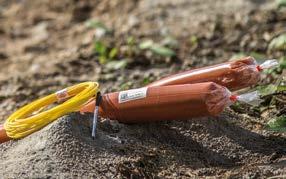





Whereas many global companies are saving money, in fear of the rising prices of energies and raw materials, Pardubice-based Explosia is investing, both in employees and in technologies. The traditional producer of smokeless powders and explosives, for example Semtex, the most famous plastic explosive in the world, is making use of its current great condition.
Explosia makes a multitude of various products, which can be divided into four groups: explosives, smokeless powders, special products and fully combustible propellant charges for large-calibre ammunition. Whenever one segment staggers, the others are able to rescue it for some time, which adds to the stability of the company. "At the moment, for example, we are tackling a decline in the interest in classical industrial explosives, intended for excavation in quarries. They are often replaced with the application of emulsion explosives directly over the drilled holes, using charging vehicles. And this is the direction a part of our investment is going," explains Radomír Krejča, Chairman of the Board of Directors of Explosia. What also contributed to the company´s good condition was an increased demand for smokeless powder. Explosia makes two basic types of the powders – single-base and double-base powders – with a different content of nitroglycerine, and also triple-base powders. Depending on the powders' production technology, we offer powders formed in flake, disc, tube and rod grains, 7-perforated grains and spherical grains. The wave of higher demands on the civil market was complemented with the deteriorated safety situation in Europe, which caused a rise of demand for items of a military kind, too. The demand for military materials is also influenced by the war in Ukraine. This situation is also increasing the pressure on Czech manufacturers' production of fully combustible propellant charges for large-calibre ammunition, where Explosia is one of the five most important global players. The company also manufactures a complete portfolio of pyrotechnical elements for pilot rescue systems in aircrafts. The company´s range also includes special products, high-quality plastic explosives for the army or police forces and other
products intended for special blasting and demolition works, or for combatting terrorism. "We are a company strictly pursuing a pro-customer approach, to make our customers totally satisfied," explains Kamil Dudek, CEO of Explosia. A significant part of the profit goes back into the production and is assigned to repairs and investments. "We respond to the increased demand and also to the fact that we can afford to do this, thanks to the current financial situation of the company," says Radomír Krejča. To be specific, about 100 million crowns per year has been invested in this direction in recent years, and even a massive increase up to double that amount occurred last year. The purpose is not only to increase the production capacity of the company, but also to enhance the safety of the manufacturing process.

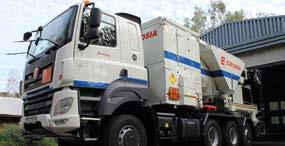

From today´s point of view, this is just a plain pencil, which everyone has at home. However, Koh-i-noor Hardtmuth, a company based in České Budějovice, made history with its innovative products. This is one of the oldest and biggest manufacturers of school, arts, and office supplies worldwide.
The history of the company dates back to 1790. It was founded by Joseph Hardtmuth, a Viennese entrepreneur. An important milestone was the year 1802, when he registered his patent for the production of pencil leads made of graphite and clay. The new leads did not break so easily and did not split like pure graphite did. They gained unexpectedly enormous popularity among customers. Pencils in general had been imported from England and had been very expensive. Therefore, Hardtmuth decided to make his own pencils. Apprenticed to a carpenter and excelling also as an architect, he could not dispense with a pencil.
KOH-I-NOOR,
In 1848, Hardtmuth´s son Carl relocated the factory to České Budějovice to save costs. Then, in 1881, the whole business was inherited by his nephew Franz, who largely modernised the family business facility. His yellow pencil was an absolute stunner. He named it Koh-i-noor, according to the famous Indian yellow diamond, adorning the British Royal crown. He presented it to the public in 1888 at the “Jubiläums-Gewerbe-Ausstellung” industrial exhibition in Vienna. The name of the pencil, which won multiple awards, was also integrated into the business name – to read as Koh-i-noor Hardtmuth. Franz also came up with a Pencil Lead Hardness Scale, which is still currently in use. The HB identification actually indicates the word connection of Hardtmuth and Budweiss, referring to Hardtmuth České Budějovice. In 1910, Koh-i-noor Hardtmuth was the biggest and most modern pencil factory in the world, with 5 branch factories and 32 sales branches all over the world, including in Japan. Twenty-seven year later, another famous pencil was born – the “Versatil” mechanical pencil enabling the replacement of the lead. The invention was welcomed especially by technicians and designers, who needed to change the hardness of the pencil lead very often. It also saved wood and the lead itself.
Both World Wars attenuated the company's activities. Having been on the rise, after 1945 the business was nationalised. After 1989, the factory was privatised and is now one of the biggest global manufacturers and distributors of art, school, and office supplies. Pencils manufactured in the České Budějovice factory are exported to almost 80 countries worldwide.
KOH-I-NOOR WALDES
A holder of the Koh-i-noor trademark is also a manufacturer of press studs, pins, zips, rivets and other haberdashery, based in Vršovice, a Prague district, which has absolutely nothing in common with pencils, except the trade name. The business was established by Jindřich Waldes, another famous industrialist and entrepreneur. He was called the Baťa of Buttons or the Button King. By the way, he literally conquered the world merely with his press stud.
At the age of 24, he decided to become independent and, together with Hynek Puc, a mechanic, they founded Waldes a spol., a company, which was originally just a small workshop in the Prague district of Holešovice, where they manufactured buttons on a treadle lathe. Thanks
to Puc´s invention of an automated machine, the production was greatly multiplied and, in 1907, the company moved to a new factory in Vršovice.
At that time, the Waldes company already had its first foreign branch (in Dresden), which was managed by Sigmund, a brother of Jindřich Waldes. Further expansion soon occurred – other branches were established in Warsaw, Paris, New York, and Vienna. The biggest domestic competitor, Lokesch, where Waldes had done his apprenticeship, was bought by Waldes in 1909. With its products, such as buttons, buckles, pins and zips, the Waldes business flooded Europe and became a giant, comparable to Baťa. Both entrepreneurs bet on automation and educated and satisfied their employees. They also invested in advertising and sophisticated management methods. A corporate support fund paid out contributions to employees at the birth of their children and for rationalisation proposals.
The most successful product of the company was a small press stud (snap fastener), which was also named after the Koh-i-noor diamond. The famous logo of Miss KIN, depicting a girl with a press stud on her eye, was originally drawn by František Kupka and adjusted by Viktor Preissig, a graphic designer. This was inspired by a photo of a girl who had accompanied Waldes on his journey to America, who put an enlarged model of the press stud on her eye, just for fun. In 1938, Waldes sent his family to America, to avoid the impending danger of Nazism. He himself, however, refused to flee. He became involved in the Resistance and supported an illegal magazine. In September 1939, he was arrested by the Gestapo and ended up in a Nazi concentration camp. Although the family finally succeeded in buying his freedom, allegedly for eight million crowns, he did not survive the journey over the ocean.
Nevertheless, the company survived both the War and the communist era, and it continues to manufacture its press studs, buttons and zips to the present day.
The University of Prague was founded by the Czech King and Holy Roman Emperor Charles IV in 1348 as the first university (studium generale) north of the Alps and east of Paris. It followed the example of the universities in Bologna and Paris, and soon beca me internationally renowned.
Charles University in figures:
n 17 faculties in 3 cities (Praha, Plzeň, Hradec Králové), 50 918 students In 2021, Charles University offered 876 study programmes, 215 of them in a foreign language. Charles University had a total of:
n 19 306 students in Bachelor´s degree programmes
n 15 227 students in Master´s degree programmes
n 9 675 students in follow-up Master´s degree programmes
n 6 710 students in Doctorate degree programmes
n 10 811 foreign students
704 foreign academics and scientists were employed by Charles University. Students could do an internship at 884 foreign institutions within the Erasmus and Erasmus+ programmes. In 2021, a total of 1 804 Czech students did internships abroad within the framework of foreign mobility.
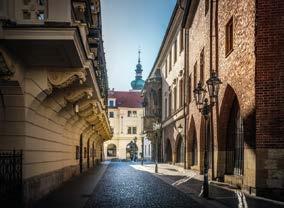
- THE LONGEST SUSPENSION FOOTBRIDGE IN THE WORLD IS IN DOLNÍ MORAVA?
The longest suspension footbridge in the world, located in Dolní Morava, is called Sky Bridge 721. As suggested by its name, this bridge is 721 metres long and, at the time of its first opening in May 2022, was the longest suspension bridge in the world. During the first month of its opening, 45 000 persons passed over the longest suspension bridge in Dolní Morava. It attracts tourists from the whole world.
The height of the footbridge from the bottom of the valley is 95 metres, the height above mean sea level is 1110–1116 metres or 1125–1135 metres. The width of the walkway is 1.2 metres. The height of the railing is 1.2 metres.
The footbridge has 6 main supporting ropes with the tractive fo rce 3.6 MN each and 60 wind ropes of various diameters. The foot -
bridge comprises 1030 square metres of concrete, ropes weighing 158 tonnes in total and 20 tonnes of additional structures. The diameter of the main rope is 76 millimetres. The total weight of the footbridge is 405 tonnes. The height of the pylons at each end of the footbridge is 11.4 metres.

- THE MOST FAMOUS CZECH SONG IS “THE BEER BARREL POLKA”?
“The Beer Barrel Polka”, or “Roll Out the Barrel”, is probably the best known Czech song in the world. It became popular in many countries during the Second World War. It was composed in 1927 by Jaromír Vejvoda as an instrumental piece of music. He adapted it in 1929, and in 1934 Václav Zeman wrote the Czech lyrics and called it “Škoda lásky” (“Wasted Love”). It became a popular song for the allied armies as well as for Czechoslovak pilots in the Battle of Britain. Its popularity is also testified by the fact that it accompanied astronauts on the Discovery Space Shuttle; it was also played in the popular M.A.S.H. series. The Vejvoda family archive records 14 titles of the song and 27 versions of the lyrics in various languages.
- THE FIRST MUSIC ON THE MOON WAS WRITTEN BY A CZECH COMPOSER?
Neil Armstrong was the first human to step on the surface of the Moon and he took with him “The New World Symphony” composed by Antonín Dvořák, which he played on the Moon. This was the first composition ever to be played in outer space.
- THE WORDS “ROBOT” AND “DOLLAR” ARE OF CZECH ORIGIN?
The word “robot” was first used in 1920 in the dramatic play, “R.U.R. –Rossum’s Universal Robots” – written by the well-known Czech playwright and journalist Karel Čapek. The word was suggested to him by his brother Josef, after Karel had asked him what name he should give to the artificial being. The originally intended “forced labour” sounded too artificial.
The word “dollar” is close to the Old Czech word “tolar”, which is related to the German “Taler”, a shortened version of the original “Joachimstaler”, meaning “of Joachimstal (of St. Joachim’s Valley)”. This was the name of the silver coin which Count Shlik started to mint in 1518 in Czech Jáchymov.

- THE WORLD’S LARGEST STADIUM IS IN PRAGUE?
The Strahov Stadium with an area of 63 000 square metres is the largest stadium in the world. The construction work started as early as in 1926. It was first used by members of the Sokol gymnastics organisation and later by members of sports associations. Currently, the FC Sparta training centre is located here. On occasion, concerts by famous stars such as The Rolling Stones are held here.
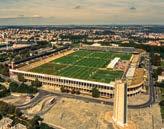
- THE FIRST SUGAR CUBE WAS MADE IN DAČICE?
In 1829, the František brothers and Tomáš Grebner established a sugar refinery – using sugar beet – in Kostelní Vydří
near Dačice. After realising that neither the climate nor the soil in the area was suitable for growing sugar beet, František decided to establish a refinery that formed raw sugar into various shapes and textures – icing sugar, castor sugar, coarse sugar, sugar loaves, sugar cubes, and chips. In 1840, Swiss-born businessman Jakub Kryštof Rad became Director of the Dačice refinery. His wife gave him the idea and, in 1841, he manufactured the first 300 white and pink cubes of beet sugar. Rad moulded them in an apparatus he himself had invented. Thus an invention was born, the practical use of which was soon to be discovered by the whole world.
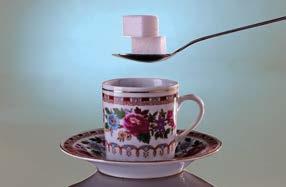
- THE CZECH REPUBLIC HAS THE OLDEST DISTILLERY IN EUROPE?
In July 2023, the Green Tree Distillery is already celebrating 505 years of its existence. The unique plant, situated in the town of Prostějov in Moravia, is the oldest producer of spirits on the Old Continent. The history of this distillery dates back to precisely 4 July 1518, when William of Pernstein and Helfstein granted brewing privileges to 31 landlords of Prostějov. The distillery has a special history, and is currently the biggest solely Czech prod ucer of spirits. Its most popular brands are Stará Myslivecká, Blend 42 Vodka, Hanácká Vodka, and Prostějovská Starorežná.
- HRANICE CHASM IS THE WORLD´S DEEPEST FLOODED CAVE?
Hranice Chasm is the deepest known freshwater cave on earth. Fi ve years ago, a team led by the Polish specialist Krzysztof Starnawski dived into it and confirmed that its depth was at least 404 met res. However, already in a 2016 descent into the cave, the hypothesis had emerged to suggest that the cave bottom was 700-1000 metres deep. The geologists’ assumption was based on figures showing t he chemical composition and temperature of the water at a depth of some 50 metres, which oscillated between 16-19 degrees Centigad e. The transparency of the water is variable; sometimes the visibility range is just 1 metre, at other times up to 50 metres. The water in the cave is a mineral water containing carbon dioxide.
- WE HAVE THE MOST DETAILED NETWORK OF HIKING TRAILS?
More than 130 years have passed since the first hiking trails w ere marked out by Czech Tourist Club enthusiasts. The Czech tourist marking system is considered as the most reliable and most detailed, not only in Europe, but also worldwide. The system of hiking trails criss-crosses the whole country, so that, with slight ex aggeration, tourists following the yellow, red, blue or green markings will easily find their destinations, from the smallest hut to t he most imposing sight. The Czech Republic has the densest network of tourist trails in Europe – with more than one kilometre of mark ed

trails per square kilometre. Regrettably, the Czech primacy cannot be confirmed with absolute certainty, because many countries do not publish information about the length of their hiking trails . Its confirmation, however, may be the fact that tourists could hardly see so many guideposts or tourist markings on trees in any othe r European country.
CZECH TRAILS BY NUMBER
n 44 101 km of hiking trails and 40 541 km of road cycling trails are marked. There are also 3 860 km of off-road cycling routes, 556 km of ski routes, 2 800 km of horse riding trails, and 149 km of wheelchair routes.
n 74 531 signposts and tables are posted on these routes, with 3 941 signposts and 1 408 mounted maps.
n In 2022, a total of 15 698 km of tourist routes were renewed and maintenance was carried out on 145 tourist maps and frames and 816 guideposts. A total of 260 km of routes were closed or rerouted.
n 1 866 sign markers worked 62 938 hours, and 104 new markers were trained.
n CZK 16.9 million was spent in 2022 on marking tourist routes and other related activities. The Ministry of Regional Development contributed CZK 8.7 million.
- WE ARE OVERALL THE MOST ACTIVE WILD MUSHROOM-PICKERS?
Perhaps nowhere else in the world is wild mushroom-picking so popular as in the Czech Republic. Each year, Czech people collect more than 20 000 tonnes of mushrooms, which is more than 6 kilograms per household per annnum.
The mushroom-hunting tradition is probably nowhere else so alive (if there is any such tradition at all), except in other Slavonic countries, Germany, the Baltic and the Scandinavian states, Finland, and Southeast Asia.

SUPREME BODIES
Office of the President of the Czech Republic
Kancelář prezidenta ČR www.hrad.cz
Parliament of the Czech Republic
Parlament České republiky
n Chamber of Deputies
Poslanecká sněmovna ČR www.psp.cz
n Senate of the Parliament of the Czech Republic
Senát Parlamentu ČR www.senat.cz
Office of the Government of the Czech Republic Úřad vlády ČR www.vlada.cz
MINISTRIES
Ministry of Foreign Affairs
Ministerstvo zahraničních věcí www.mzv.cz
Ministry of Industry and Trade Ministerstvo průmyslu a obchodu www.mpo.cz
Ministry of Finance
Ministerstvo financí www.mfcr.cz
Ministry of Transport Ministerstvo dopravy www.mdcr.cz
Ministry of Agriculture
Ministerstvo zemědělství www.mze.cz
Ministry of Regional Development Ministerstvo pro místní rozvoj www.mmr.cz
Ministry of the Interior Ministerstvo vnitra www.mvcr.cz
Ministry of Justice Ministerstvo spravedlnosti www.justice.cz
Ministry of Defence Ministerstvo obrany www.army.cz
Ministry of the Environment Ministerstvo životního prostředí www.env.cz
Ministry of Labour and Social Affairs
Ministerstvo práce a sociálních věcí www.mpsv.cz
Ministry of Health Ministerstvo zdravotnictví www.mzcr.cz
Ministry of Education, Youth, and Sport Ministerstvo školství, mládeže a tělovýchovy www.msmt.cz
Ministry of Culture Ministerstvo kultury www.mkcr.cz
DIPLOMATIC MISSIONS OF INTERNATIONAL ORGANISATIONS
Representation of the European Commission in the Czech Republic E-mail: comm-rep-cz@ec.europa.eu www.evropska-unie.cz
Organisation for Security and Co-operation in Europe Prague Office of the OSCE Secretariat E-mail: quest@osce.org www.osce.org
United Nations Information Centre Prague E-mail: unicprg@osn.cz www.osn.cz
European Parliament Information Office Prague E-mail: eppraha@europarl.europa.eu www.evropsky-parlament.cz
Representation of the European Investment Bank E-mail: Prague@eib.org www.eib.org
European GNSS Agency E-mail: info@gsa.europa.eu www.gsa.europa.eu/
International Organization for Migration E-mail: prague@iom.int www.iom.cz/
UNHCR National Office Czech Republic E-mail: czepr@unhcr.org www.unhcr.org/cz/
World Health Organization –Prague Office E-mail: eurowhocz@who.int www.who.int
The data presented in this publication are current at the time of the editorial deadline.


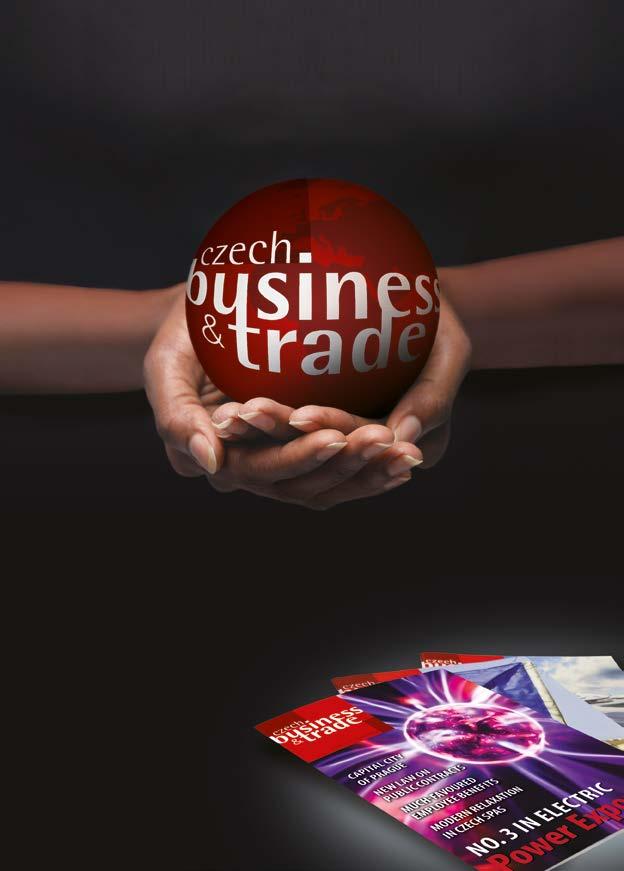
PRO F ESSION AL ECONOMIC QUARTER LY WITH A LONGER T H A N 9 5 - Y EAR TRADITION, WHICH INFOR M S ABOUT T HE S TANDARD AND PROSPECTS OF THE CZE CH ECONOMY
I T I S DESIGNE D FO R FOREIGN PE RS ONS IN TERE STED I N BUSINESS IN THE CZECH RE PUBLIC
CO NT E NT S: t op ic al in for m a tion about the b us iness en vi ronment , the industrial sectors and the dif feren t re gion s, an d pr esentat ion of pr o m ine nt C zec h fi rms w it h good prospe cts
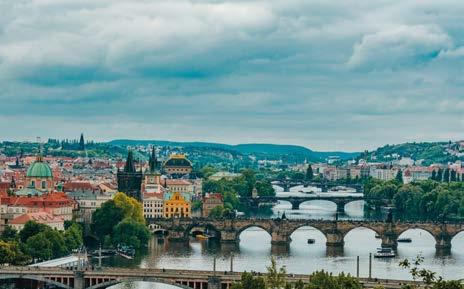
Czech National Bank
Česká národní banka
Na Příkopě 28, 115 03 Praha 1
Phone: +420 224 411 111 www.cnb.cz/en/public/contacts/
Confederation of Industry of the Czech Republic
Svaz průmyslu a dopravy České republiky
Freyova 948/11, 190 00 Praha 9
Phone: +420 225 279 111
E-mail: spcr@spcr.cz www.spcr.cz
Czech Chamber of Commerce
Hospodářská komora České republiky
Na Florenci 2116/15, 110 00 Praha 1
Phone: +420 266 721 300
E-mail: office@komora.cz www.komora.cz
Czech Centres - headquarters Česká centra - centrála
Václavské nám. 816/49 110 00 Praha 1
Phone: +420 234 668 211
E-mail: info@czech.cz https://www.czechcentres.cz/en/
National Committee of International
Chamber of Commerce in the CR Národní výbor Mezinárodní obchodní komory v ČR
Václavské náměstí 796/42
– entrance from Štěpánská street
Phone: +420 257 217 744
E-mail: icc@icc-cr.cz www.icc-cr.cz
Enterprise Europe Network
Centrum pro regionální rozvoj České republiky
U Nákladového nádraží 3144/4
130 00 Praha 3
Phone: +420 225 855 312
E-mail: een@crr.cz www.crr.cz
Czech Tourism Centre - CzechTourism
Česká centrála cestovního ruchuCzechTourism
Štěpánská 567/15, 120 00 Praha 2
Nové Město
Phone: Please see the web for detail phone numbers
E-mail: info@czechtourism.cz www.czechtourism.cz
CzechInvest
CzechInvest
Štěpánská 15, 120 00 Praha 2
Phone: 727 850 330
E-mail: recepce@czechinvest.org www.czechinvest.org
CzechTrade
CzechTrade
Štěpánská 15, 120 00 Praha 2
Phone: +420 224 907 576
E-mail: kcexport@businessinfo.cz www.czechtrade.cz
Export Guarantee and Insurance Corporation
Exportní garanční a pojišťovací společnost, a.s. Vodičkova 34/701, 111 21 Praha 1
Phone: +420 222 841 111
E-mail: info@egap.cz www.egap.cz
Czech Export Bank
Česká exportní banka, a.s. Vodičkova 34, 111 21 Prague 1
Phone: +420 222 841 100
E-mail: ceb@ceb.cz www.ceb.cz
Published by the PP Agency s.r.o. 2000 – 2023

A lgeria Argentina Armenia Austria Bahrain Belarus Belgium Brazil Brunei Bulgaria Cambodia Canada Chile China Colombia
Croatia Cuba Denmark Estonia Finland France Georgia Germany United Kingdom Hungary Iceland India Indonesia Iran Iraq
Ireland Italy Japan Kazakhstan Kuwait Kyrgyzstan
Laos
Latvia
Lithuania Luxembourg Malaysia Mexico Moldova Montenegro Morocco
Netherlands
Norway Oman
Peru
Philippines Poland
Portugal Qatar
Romania
Russia
Saudi Arabia
Serbia
Singapore
Spain
Sweden
Tajikistan
Tunisia
Turkey
Turkmenistan
Ukraine
United Arab Emirates
United States
Uzbekistan
Viet Nam
Switzerland
General information on the Czech Republic www.czech.cz
Business Info www.businessinfo.cz
Doing Business in the Czech Republic www.doingbusiness.cz
Portal of the Public Administration www.vlada.cz
Company Contact Information
ARES http://wwwinfo.mfcr.cz/ares/ ares.html.en
Hoppenstedt Bonnier www.hbi.cz
Official site for the CR
Official site for professionals searching for information, assistance, or business contacts in the CR
General information about business climate, structure, and development of the Czech economy
The electronic gateway for the public to administration and government services
Access to Registers of Economic Subjects/Entities
The most important companies in the CR and the SR Inform.cz www.inform.cz
Kompass www.kompass.com
European Databank www.edb.cz
Catalogue of Czech companies
Czech Republic B2B Suppliers
Companies Catalogue
Government Pro Export Company – Czech Trade http://exporters.czechtrade.cz/en/ Czech Exporters Directory
Finance
Czech National Bank www.cnb.cz
Prague Stock Exchange www.pse.cz
RM-System www.rmsystem.cz
Czech Insurance Association www.cap.cz
Statistics
Czech Statistical Office www.czso.cz
Fairs and Exhibitions
BVV – Brněnské veletrhy a výstavy/ Trade Fairs Brno www.bvv.cz
Miscellaneous
The Industrial Property Office www.upv.cz
The Czech Science Foundation www.gacr.cz
Monetary, financial, and macroeconomic data
Prague Stock Exchange data
RM-System Czech Stock Exchange
Directory of insurance companies operating in the CR
Official statistical data and information covering different subjects
List of exhibitions in Brno and relevant information
Patents, trade marks, utility models, and industrial designs
Awards grants to the best projects of basic research in all branches of science Česká pošta (Czech Post) www.ceskaposta.cz
Association for Foreign Investment www.afi.cz
Cadastre of Real Estate www.cuzk.cz
Electronic Toll System in the CR www.mytocz.eu
National Register of Vocational Qualifications www.narodni-kvalifikace.cz
The Czech Association of Hotels and Restaurants www.ahrcr.cz
Incl. postcodes of municipalities and its districts (PSC), philately etc.
Support for entry of foreign investors
Information system, contains data on real estate in the CR
Information on road toll and charges
Register of nationally recognised vocational qualifications
Directory of hotels in the CR




– this is Luční


This is not only the biggest and oldest lodge in the Krkonoše Mountains, but it also has the highest restaurant, located at an altitude of 1 410 metres above sea level. Luční bouda is situated on the crossroads of several old trails, near the State border with Poland, in the centre of the marvellous White Meadow and, most importantly, near the most famous Silesian Road.
Guests at Luční bouda have included Franz Joseph II, General Ernst Gideon von Laudon, and the Czech fictional character of Jára Cimrman. We hope that the cosiness of our guest rooms, delicious food, our famous giant rolls and a glass of our PAROHÁČ beer will make your visit to this unique place with an amazing view of the surrounding landscape even more comfortable. We look forward to meeting you.
www.lucnibouda.cz
The Czech firm Fenix is one of the largest European manufacturers of electric heating systems, as well as an important exporter. The company exports its products to more than 70 countries across 5 continents and was ranked first in the “Large Company” category in the 2020 Czech Exporters’ Awards Competition. Its core business is the manufacture and sale of electric heating systems, with ECOFILM floor and ceiling heating foils, heating cables, cable mats and ECOFLOOR antifreeze systems, ECOSUN radiant heating panels, and recently also HES battery storage facilities for household and industrial use as the backbone of the group´s production programme.
The firm, which started as a small garage workshop making electric radiant panels, has become an important player in the market with a turnover of more than CZK 1.9 billion. In addition, this is a company which can justifiably serve as an example of showing the usefulness of including the younger generation in the company management. For the whole duration of its existence, the company´s head has been the father, Cyril Svozil, Director and owner of the holding. His daughter, Kateřina Jezerská, has several years behind her of successful employment in the position of Executive Director of the Spanish affiliation of CEILHIT. Since January 2017, she has been Director of Fenix Trading s.r.o., generating the highest revenue among the firm´s subsidiaries. The Director’s son, Cyril Svozil Jr., who spent 8 years in France as head of the company´s affiliation, ACSO, now heads the department concerned with the development and manufacture of battery storage facilities and is gradually taking over the management of the entire Fenix Group.
“The year 2020 was for us one that can be characterised as a year of investment, which we estimate at about CZK 180 million. Fenix Group was joined by the Serbian company of Elmark. We enlarged production lines in the Spanish company of Ceilhit and increased automation in our plant in Jeseník. The construction of a new Fenix plant in Slovakia has been postponed until later this year, due to the Coronavirus pandemic,” says Kateřina Jezerská.
“The sales in 2021 were absolutely the best in the whole history of the company. What is also positive is the fact that an absolute majority of our subsidiaries are doing well. This will provide a reserve against fluctuations on particular markets, on which we always have to count. And we are also pleased that the Czech market has kept growing,” says Ing. Cyril Svozil. “Nevertheless, we have to be cautious during this year and consistently analyse the changing situation. Last year, adverse developments hit the power sector, on which we essentially depend. So it is necessary to search actively for new opportunities, which will certainly be brought about by the upcoming crisis.”
Besides comfortable heating in residential houses, heating cables and panels have also proven themselves in agriculture and industry, e.g. for heating the soil in greenhouses, protection of vines in vineyards against frost and heating livestock stables. In recent years, heating cables have found their use in heating football pitches. They are becoming popular in the European market, in the heating of playground surfaces with
artificial grass. In 2018 and 2019, Fenix supplied heating cables and heating mats on 15 football pitches with artificial grass in Norway. Long-term experience shows that electric heating responds very quickly to today´s frequent temperature changes and using this type of heating is therefore much more economical. In addition, hot-water systems are unable to ensure such flexibility and such precision of small amounts of heat supplies as electric heating. Currently, the holding has affiliations in 9 countries. In addition to the Czech Republic, it also has affiliations in Slovakia, France, Spain, the UK, Norway, Germany, and Poland, and since 1 January 2021, also in Serbia. The firm employs 350 people in these countries (180 in the Czech Republic).
BATTERY STORAGE SYSTEMS PROVIDE NEW CHALLENGE FOR FENIX GROUP
Since 2016, the company has been testing these systems in their Office Centre in Jeseník, to gain first-hand experience of their usage for nearly zero-energy buildings (NZEBs). Moreover, since 2018, the Fenix Group has been operating an SAS system for the management of energy consumption peaks, which is one of the biggest battery energy storage systems in the Czech Republic. It is manufactured by the AERS subsidiary.
“In the segment of battery stations and battery storage facilities for industrial use, we are going to offer three basic types of solutions. Our HES battery stations using the second-life batteries from the automotive sector are made and supplied with the capacity from 13.7 to 41 kWh and their strengths will be appreciated especially by owners of photovoltaic cells installed on family houses. Our Distributed Energy Storage (DES) systems with the capacity of 300 kWh are intended for a wide range of users engaged in manufacturing, commerce and services; large peak-shaving systems with the capacity of 600 kWh and more are ideally applicable in the industrial sectors,” says Mgr. Cyril Svozil Jr.
“We deliver this system to customers in an ‘all-in-one’ finish, so all they need to do is to attach the cables from FVE panels and, on the other side, to connect it to the internal electrical network of the building,” says Cyril Svozil Jr., adding: “For a long time, the absence of an affordable storage of energy had limited possibilities of energy savings and consumption cuts. With the development of new accumulation systems and their prices dropping, the situation is changing – renewable energy sources, together with an energy storage system, are becoming an affordable alternative for property owners.”

| AN ENVIRONMENTALLY FRIENDLY SOLUTION | SMART GRID COLLABORATION, HELPING TO KEEP SUPPLY GRIDS BALANCED | HIGH LEVEL OF USER INDEPENDENCE FROM PARTIAL TO TOTAL HOME BATTERY SYSTEM HE S - ALL IN ONE, 3 PHASE, 10KW, ASYMMETRICAL LOAD, 2X MPPT, OFF-GRID REGIME, BATTERY CAPACITY 13,7-41,1 KWH
ECOSUN panels

ECOFILM heating foil

ECOFLOOR cables and mats

ECOSUN TH panels Address:


